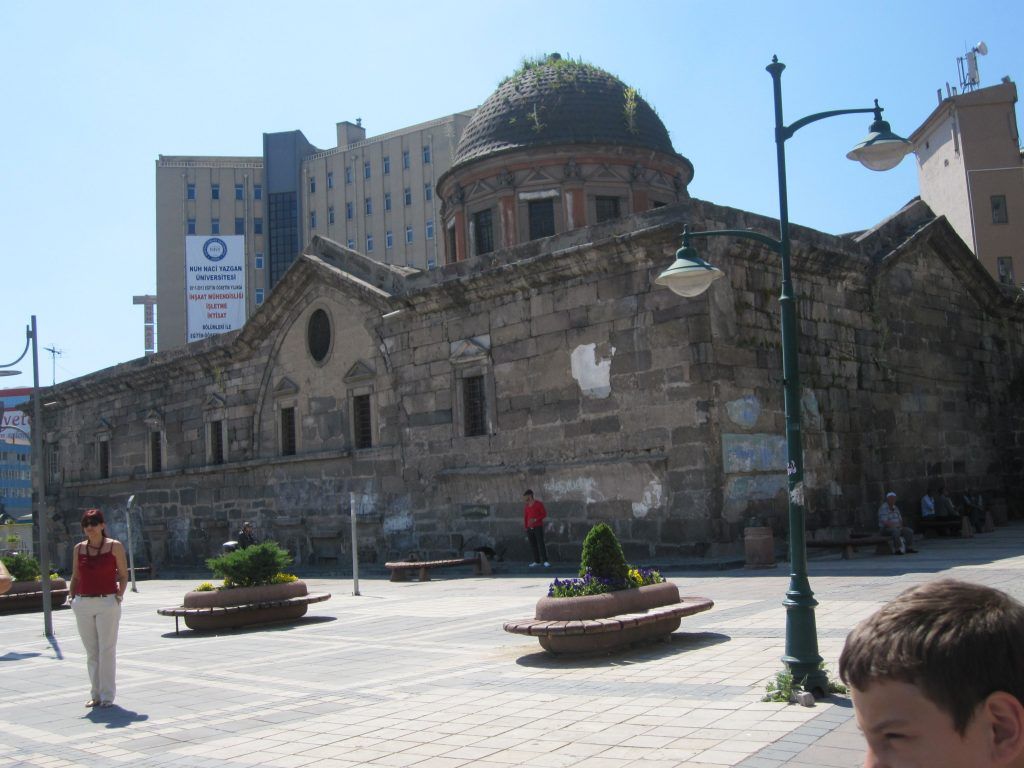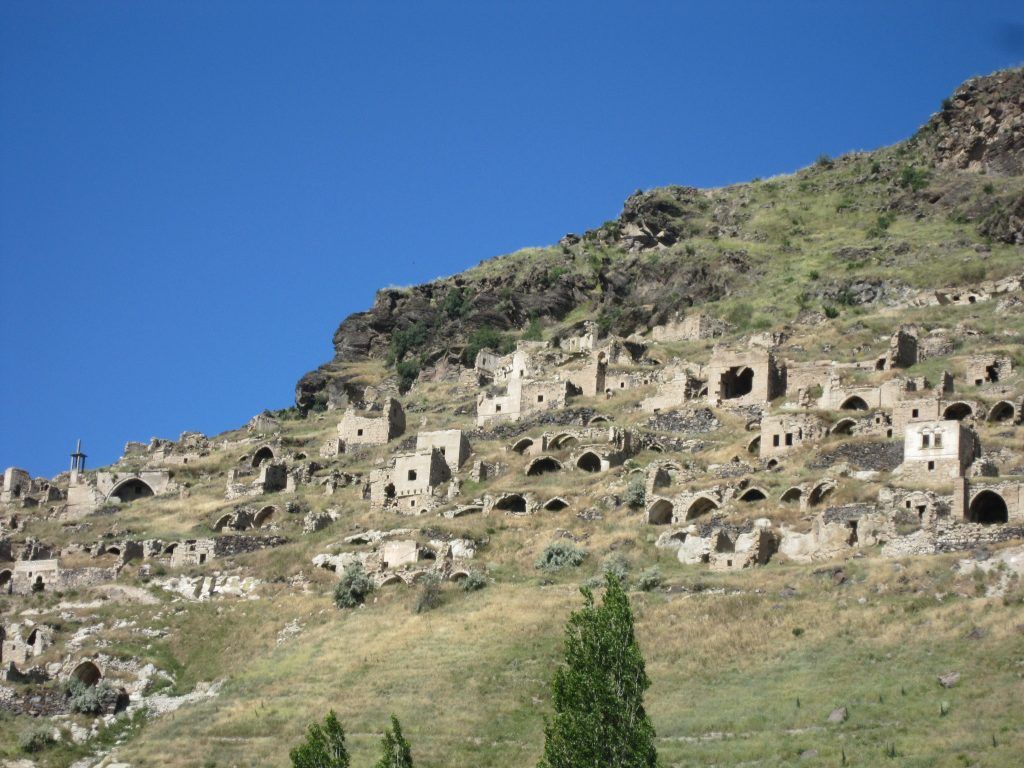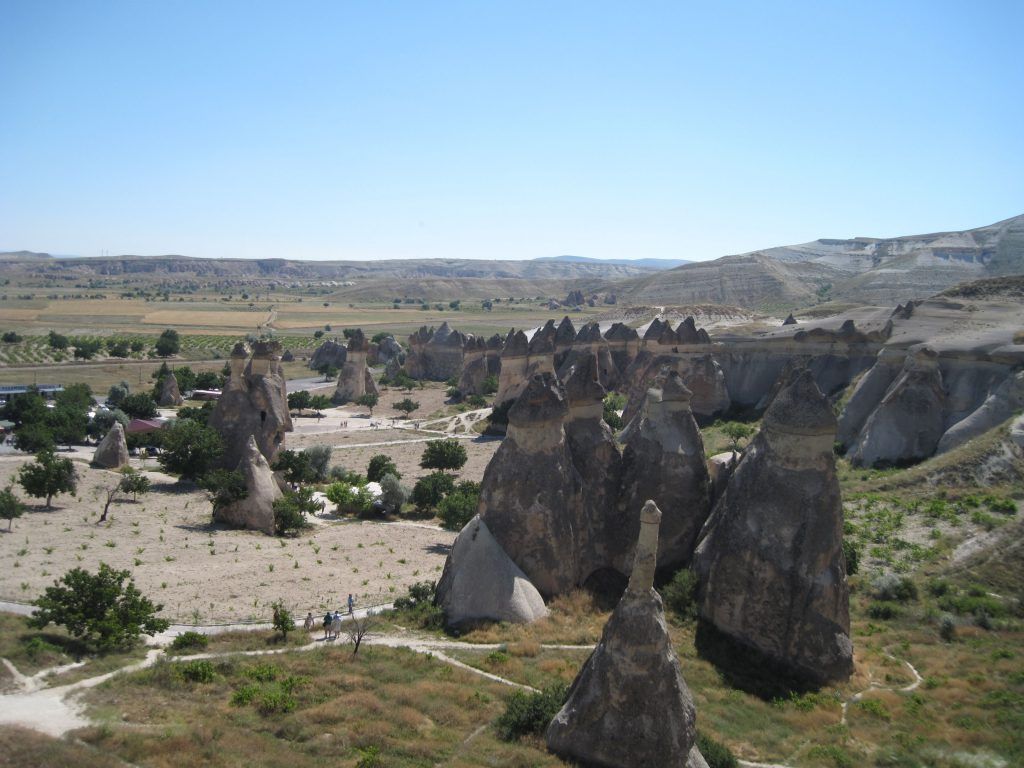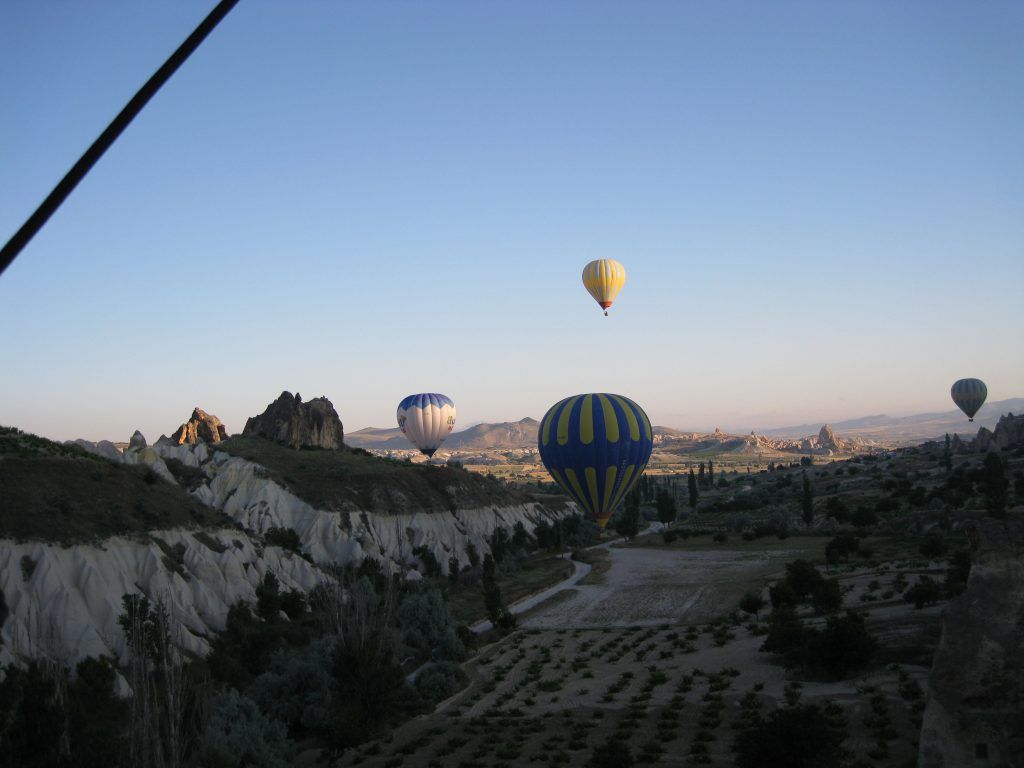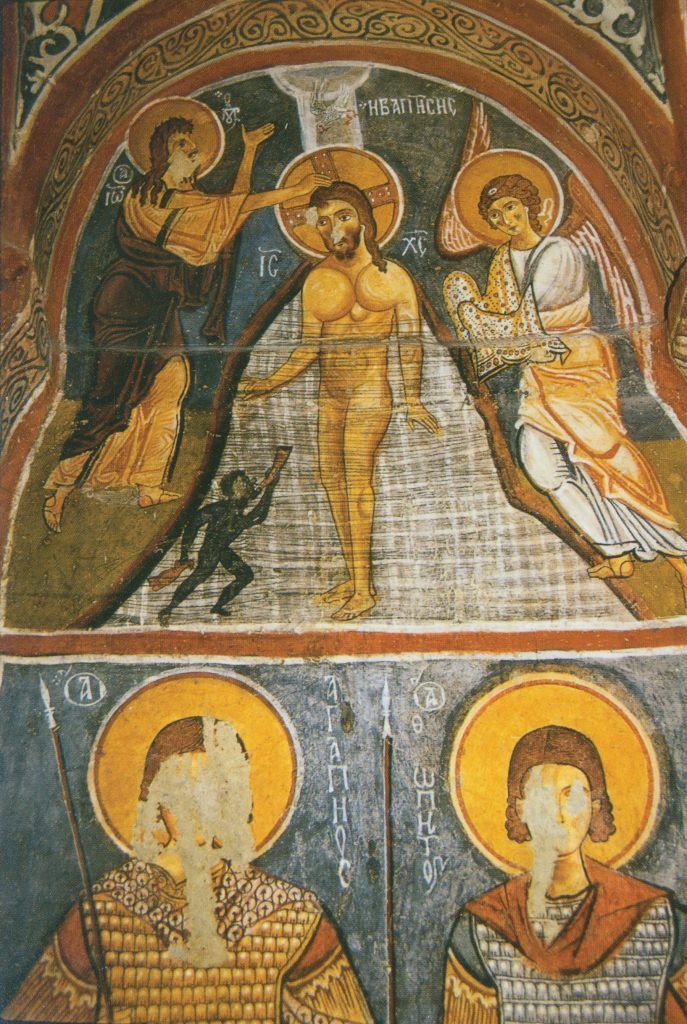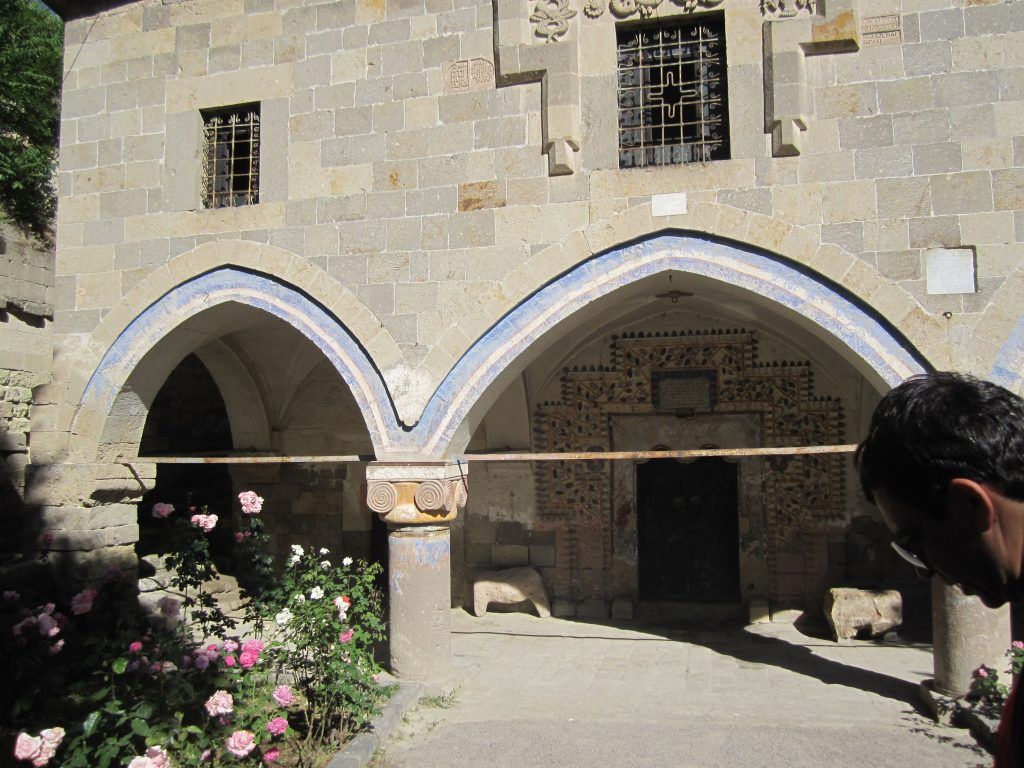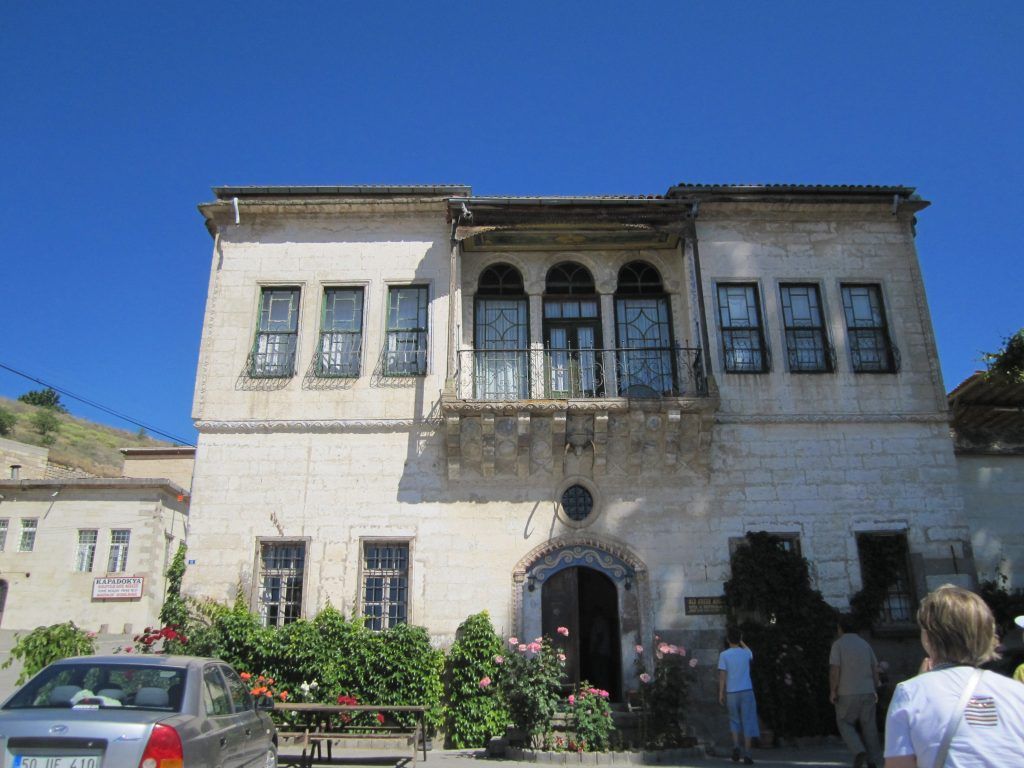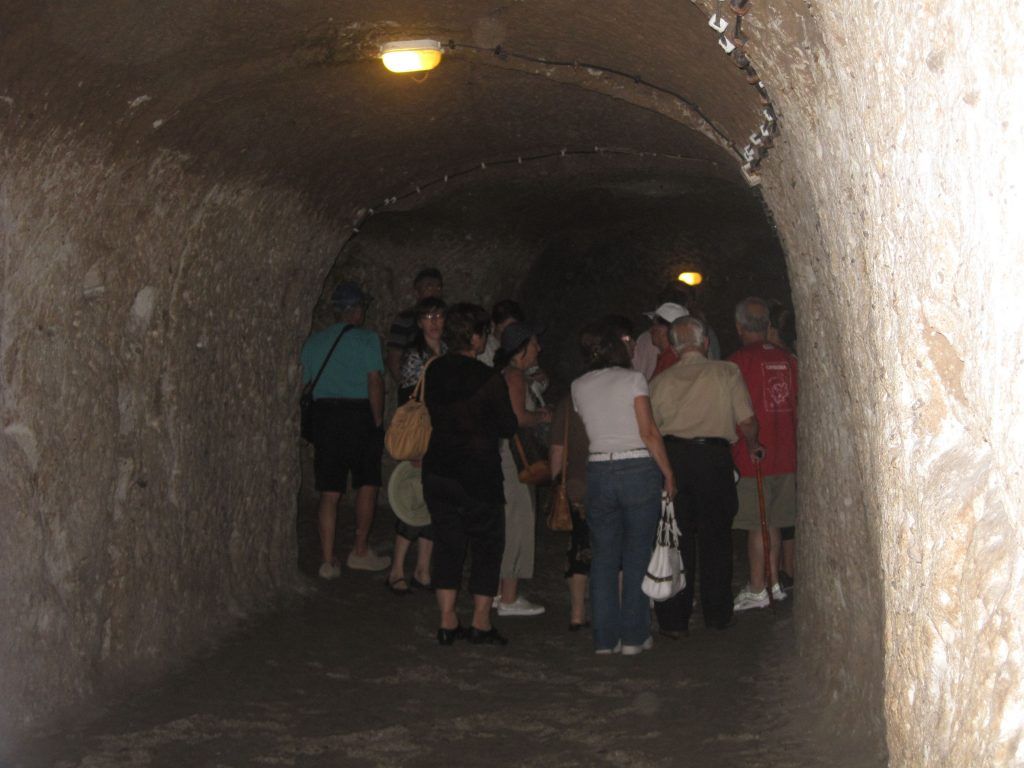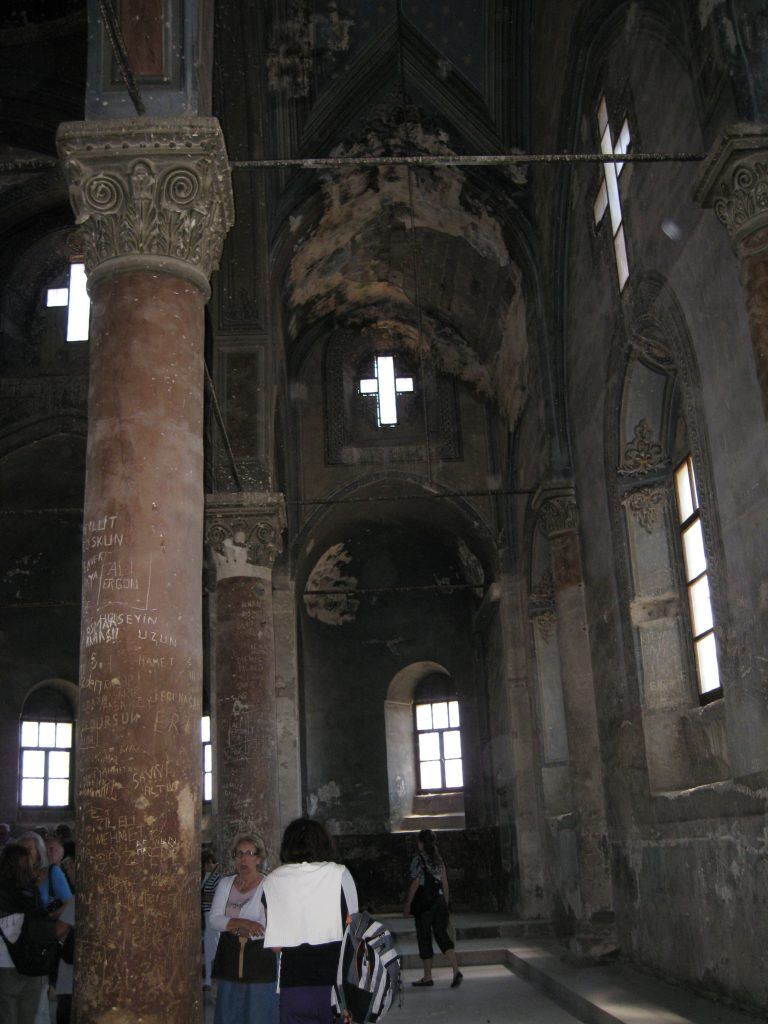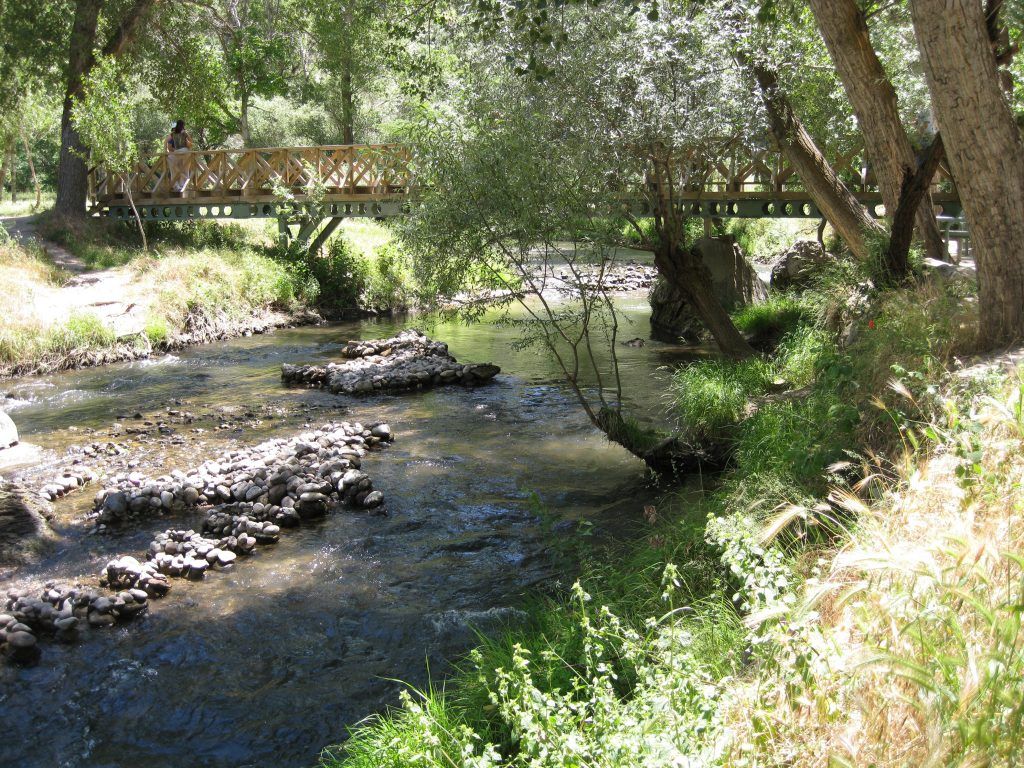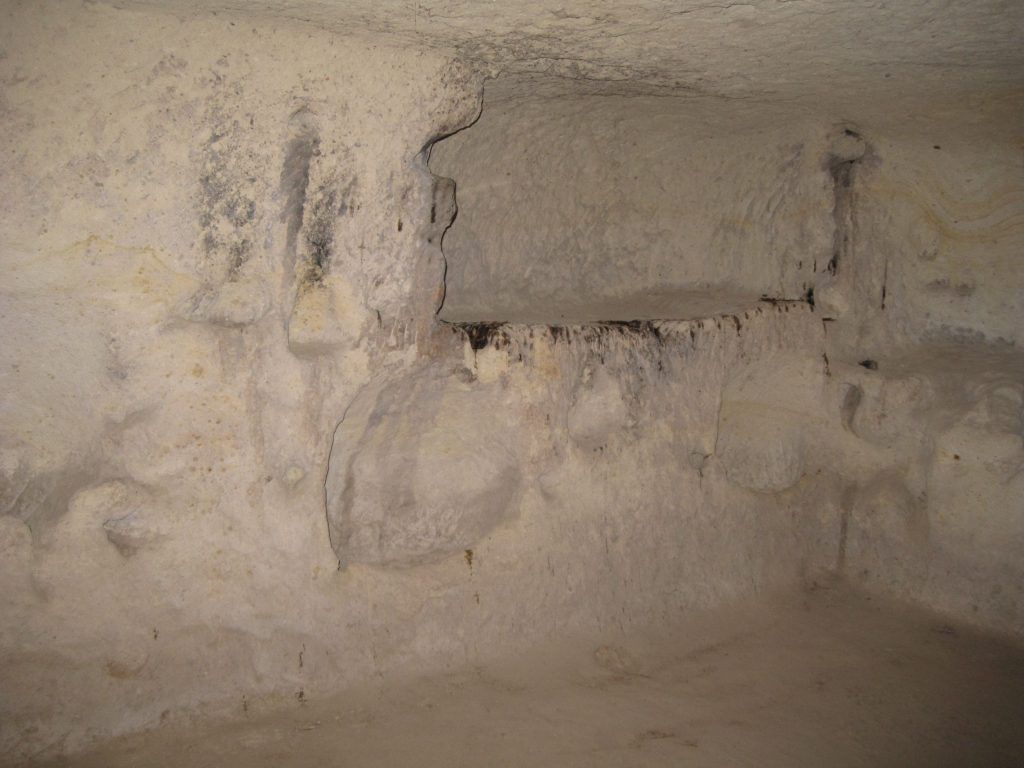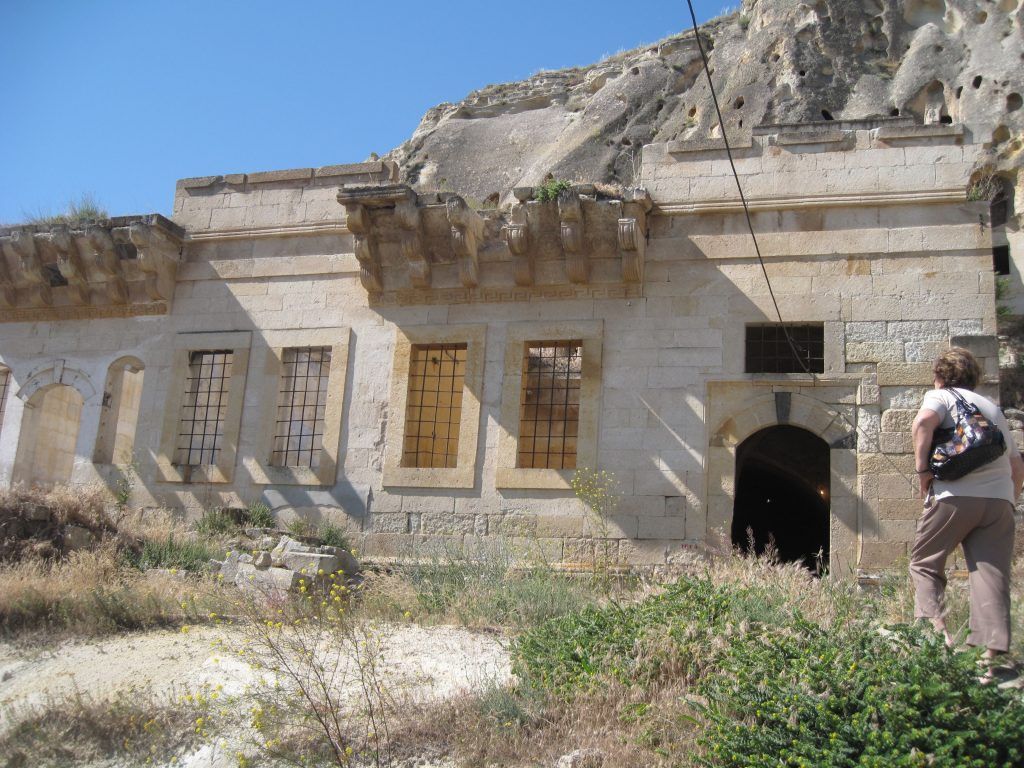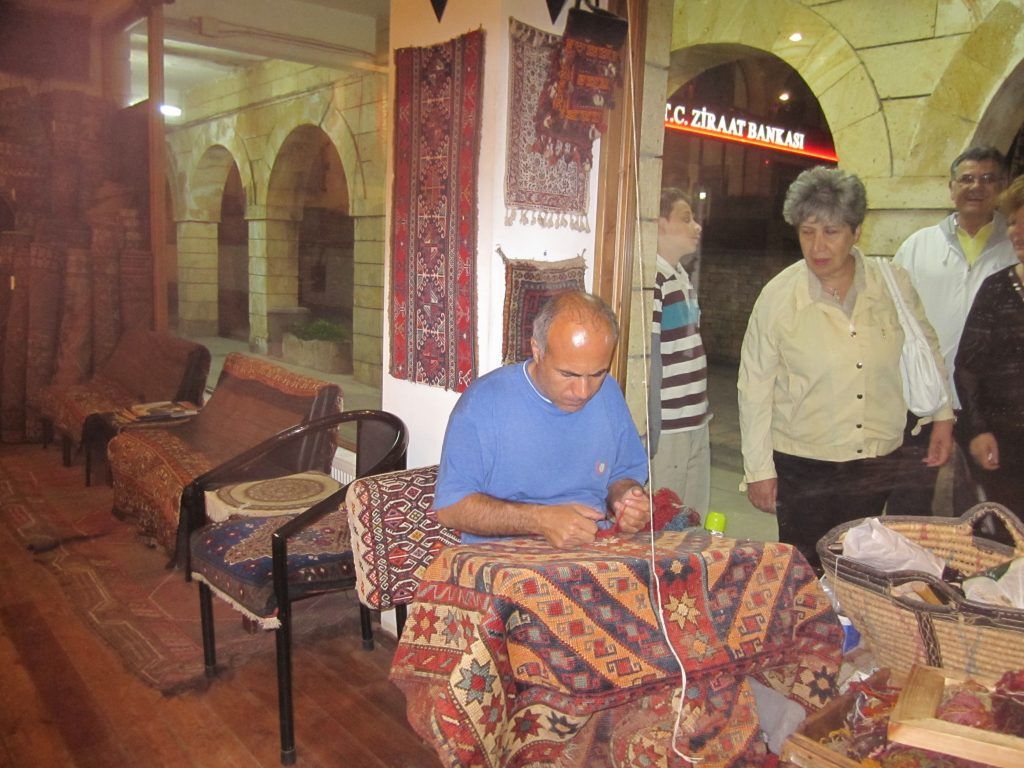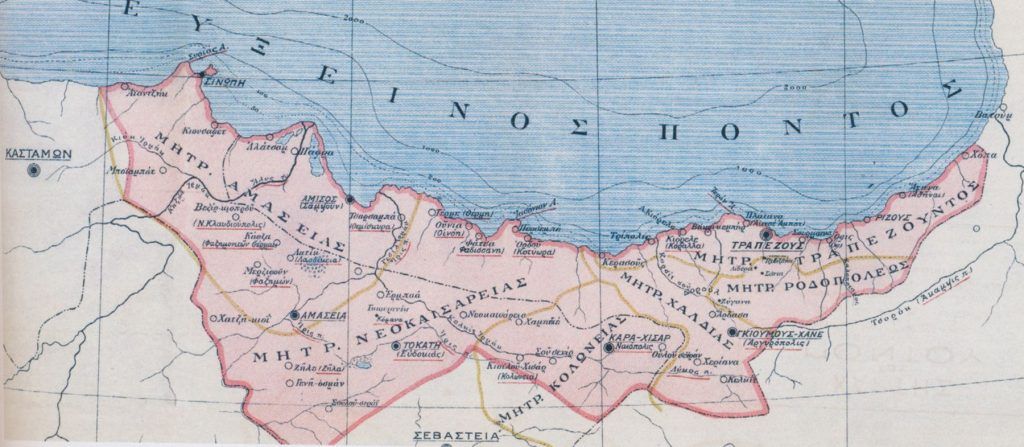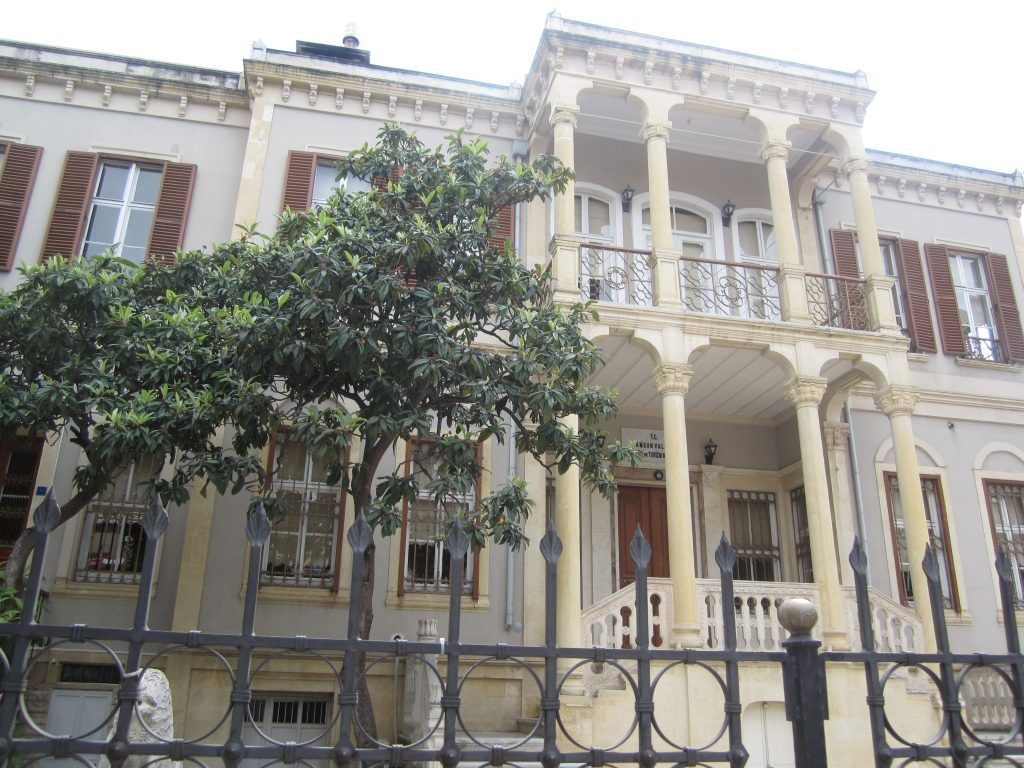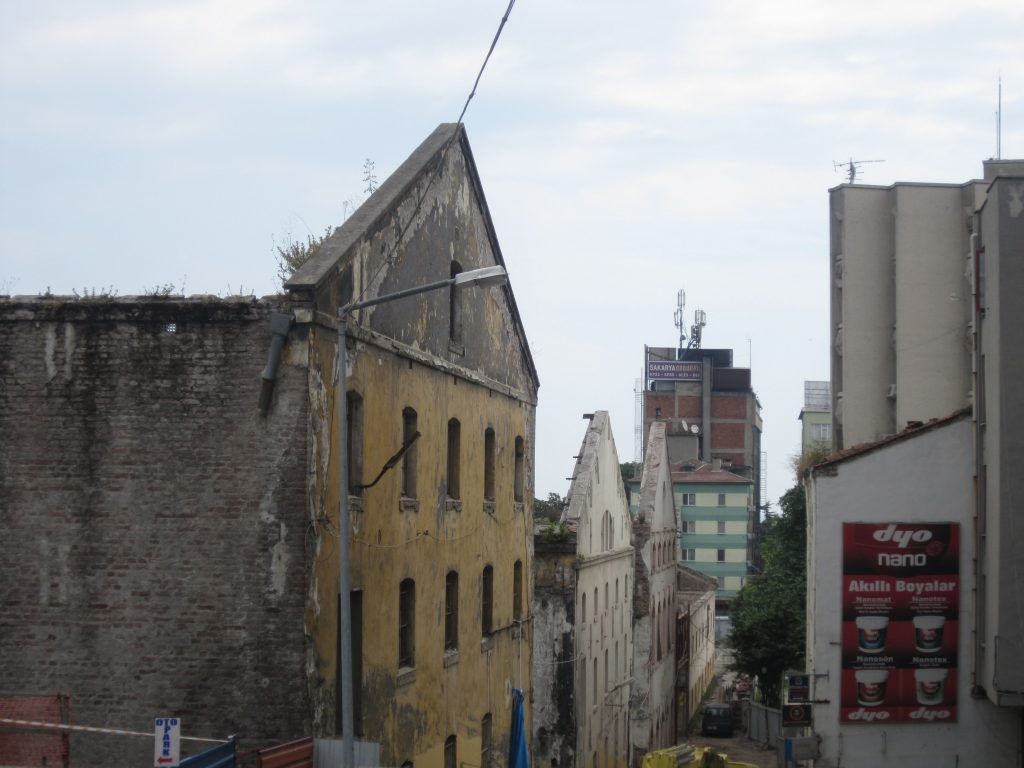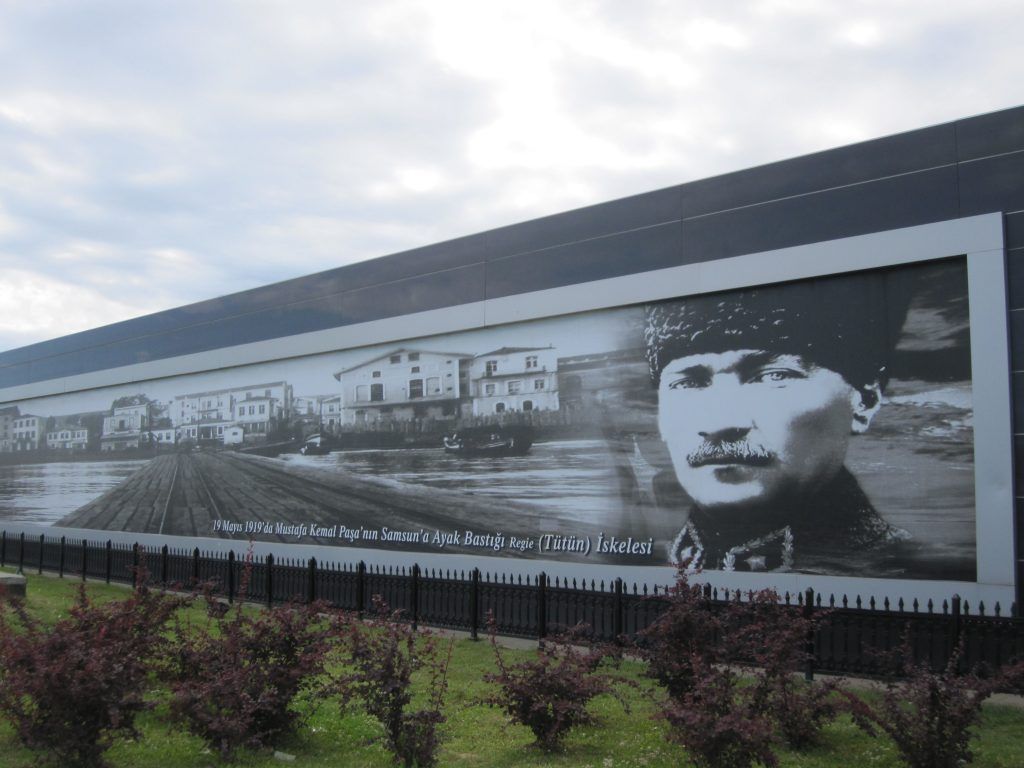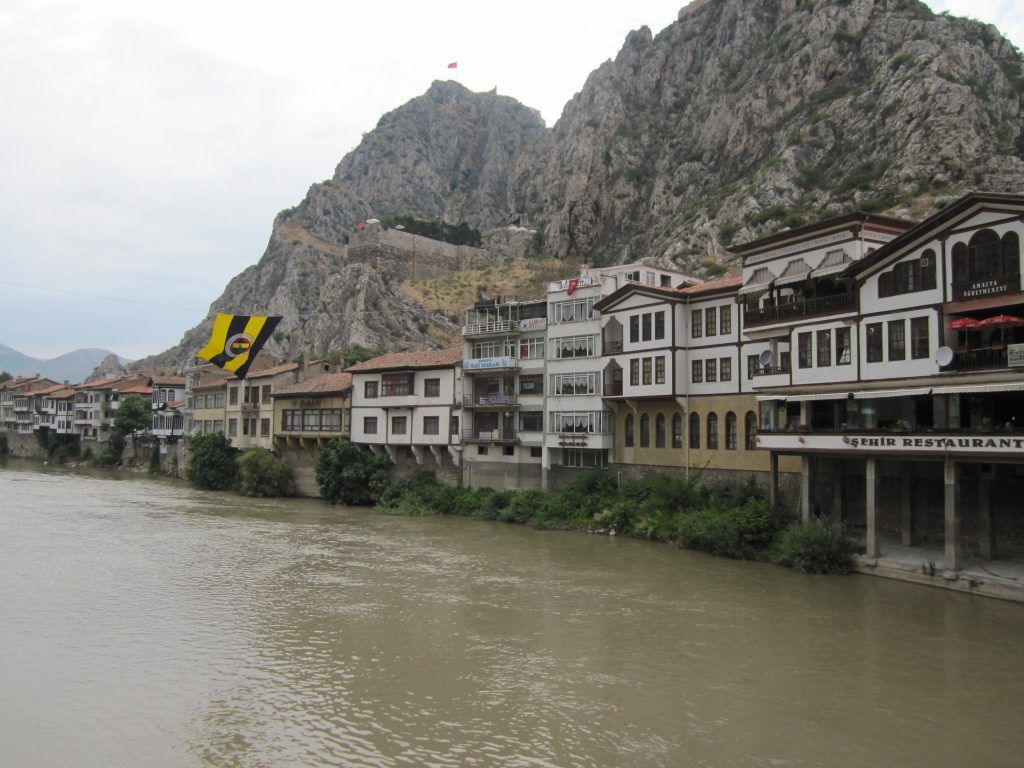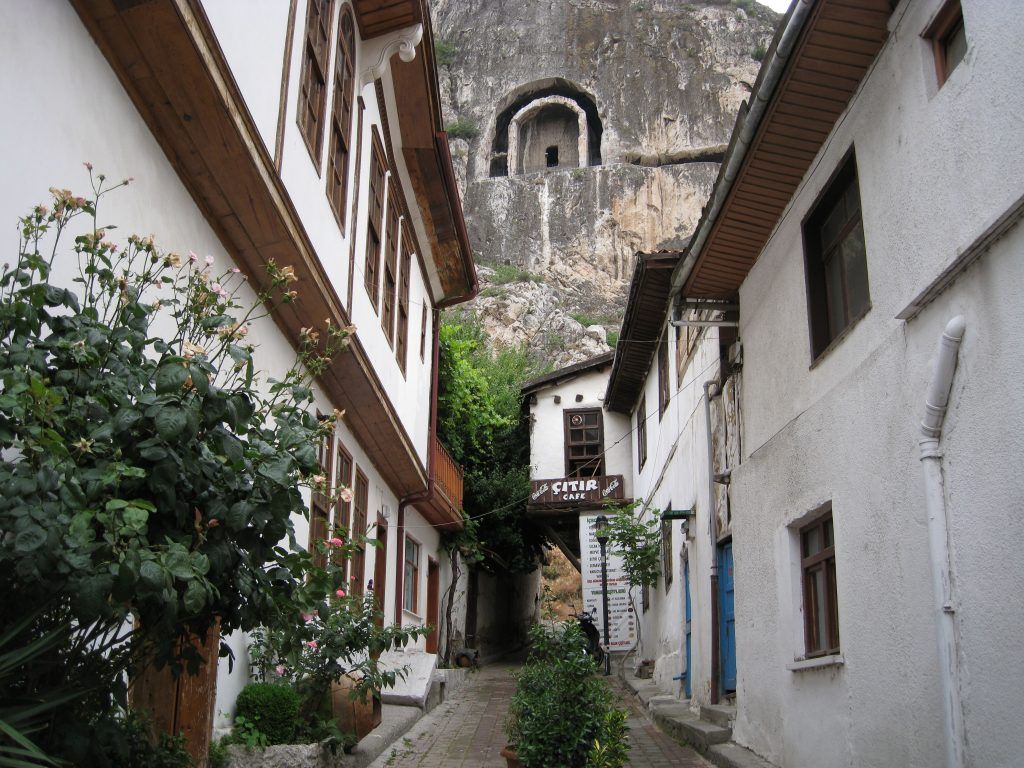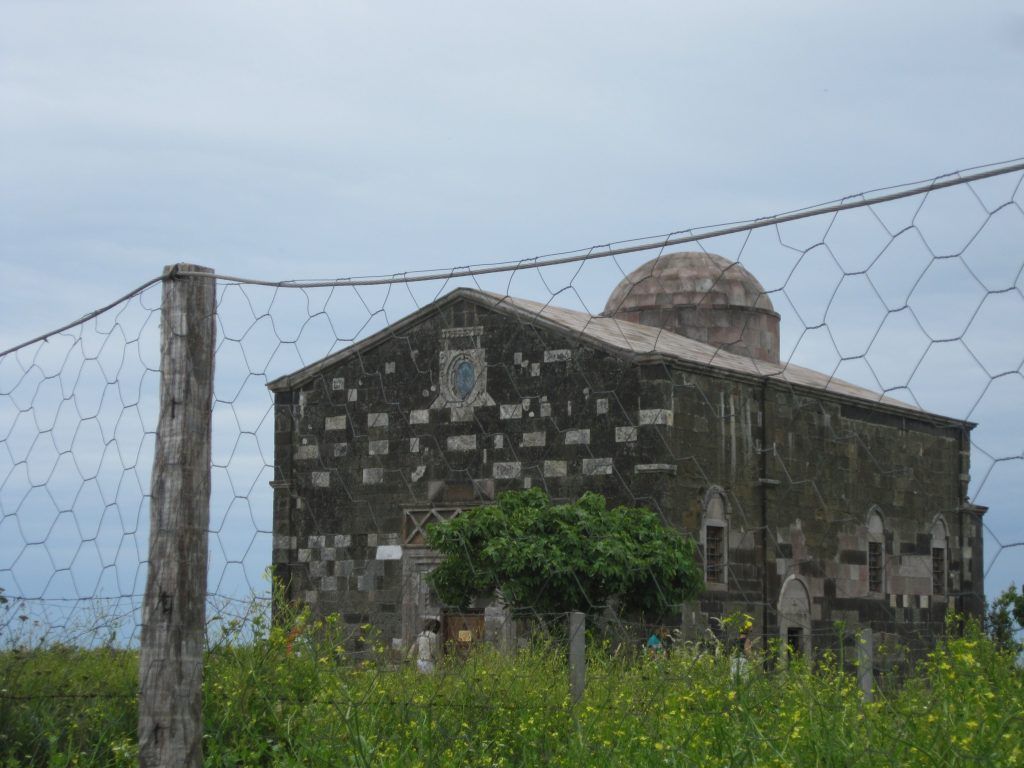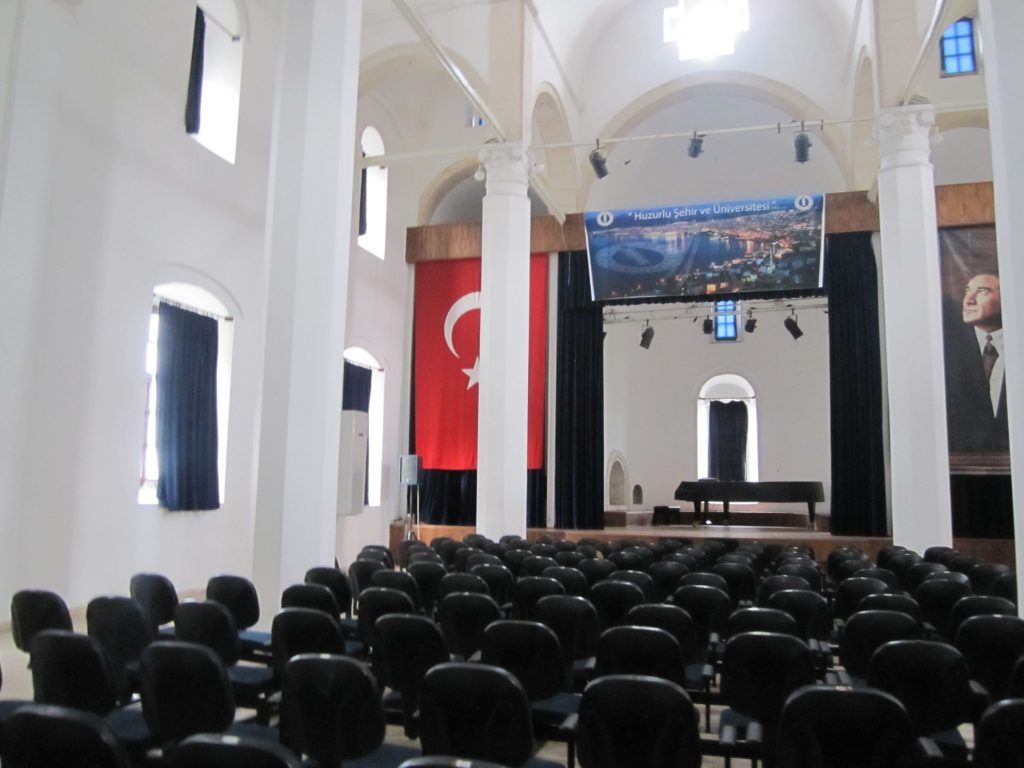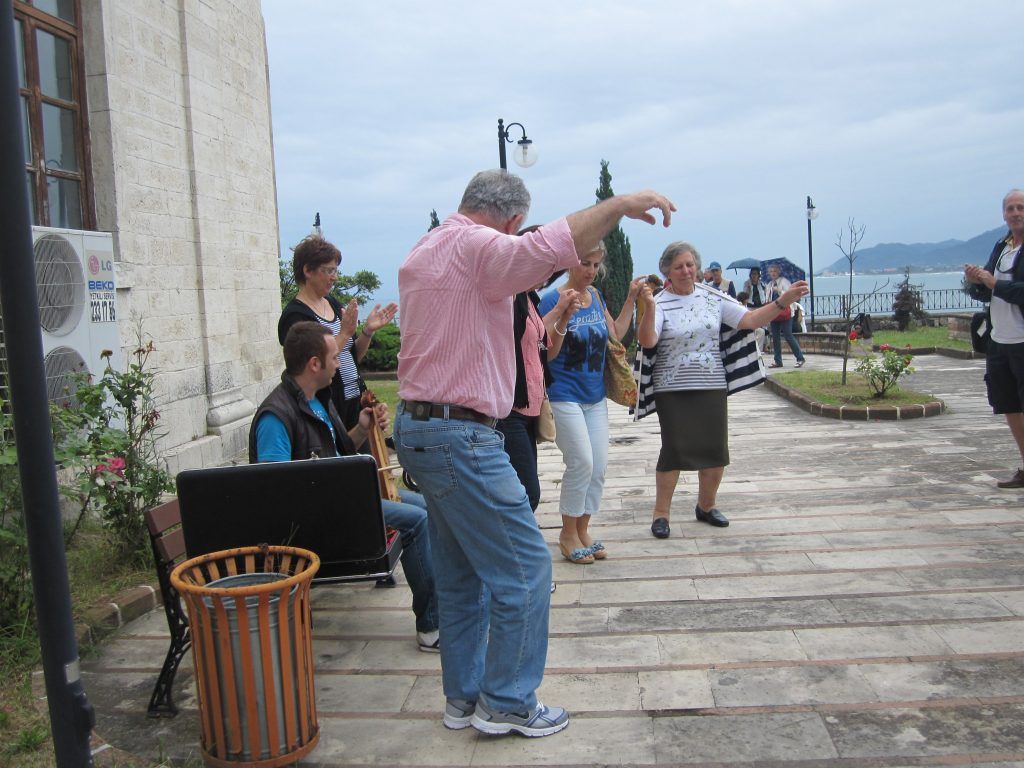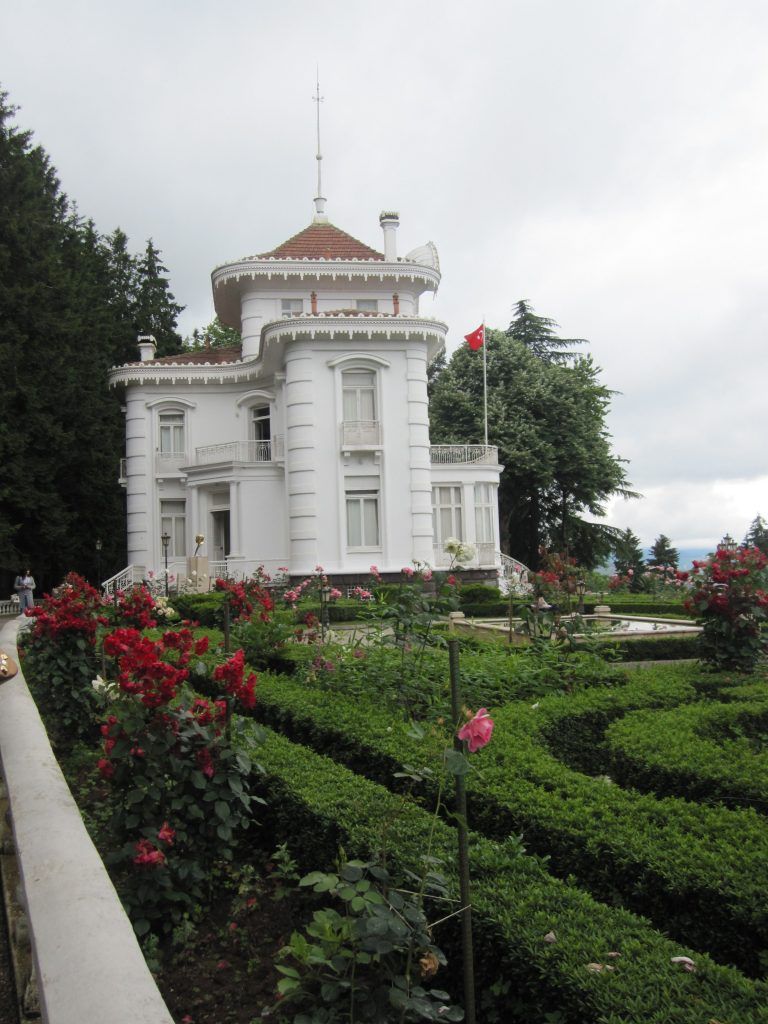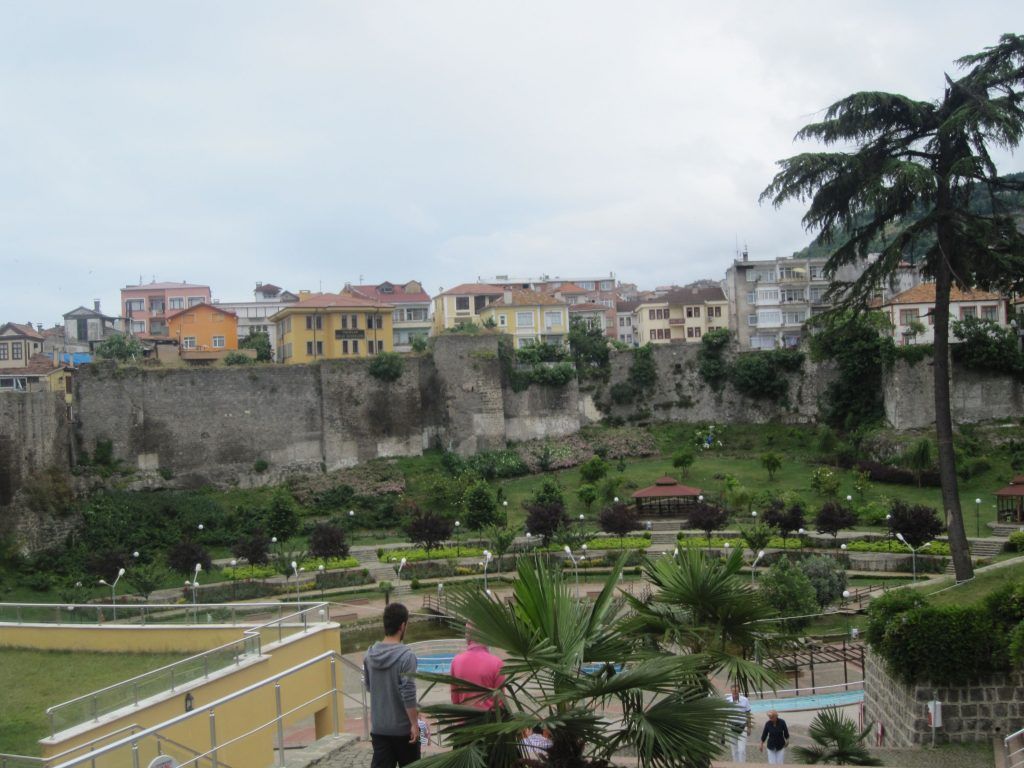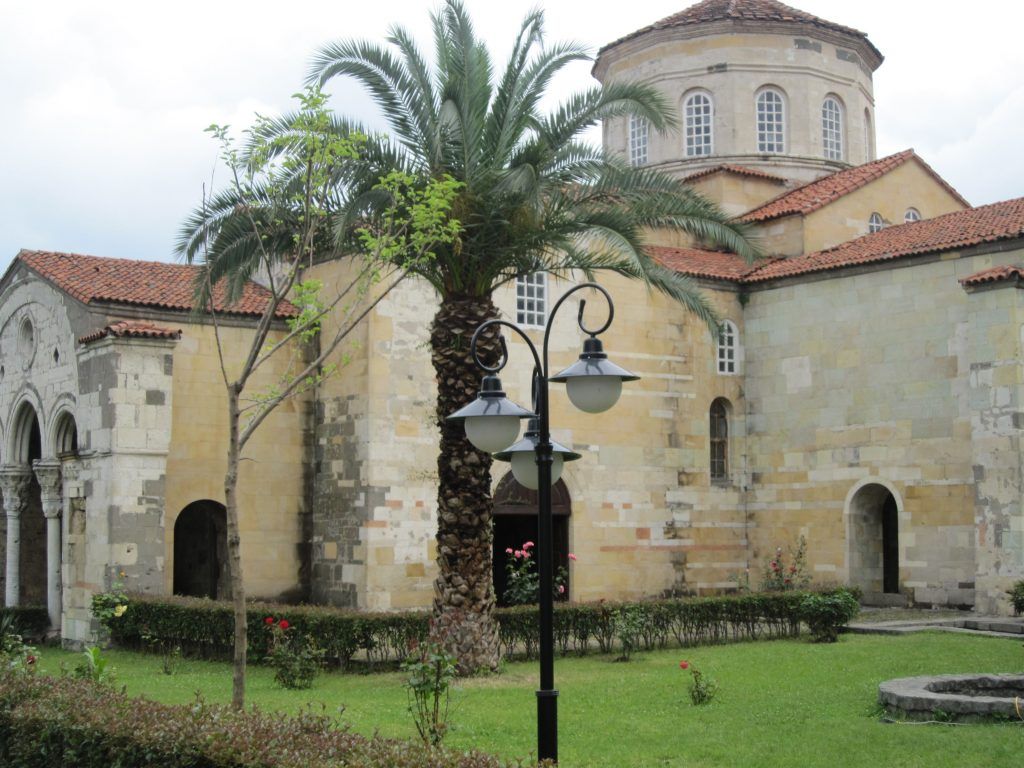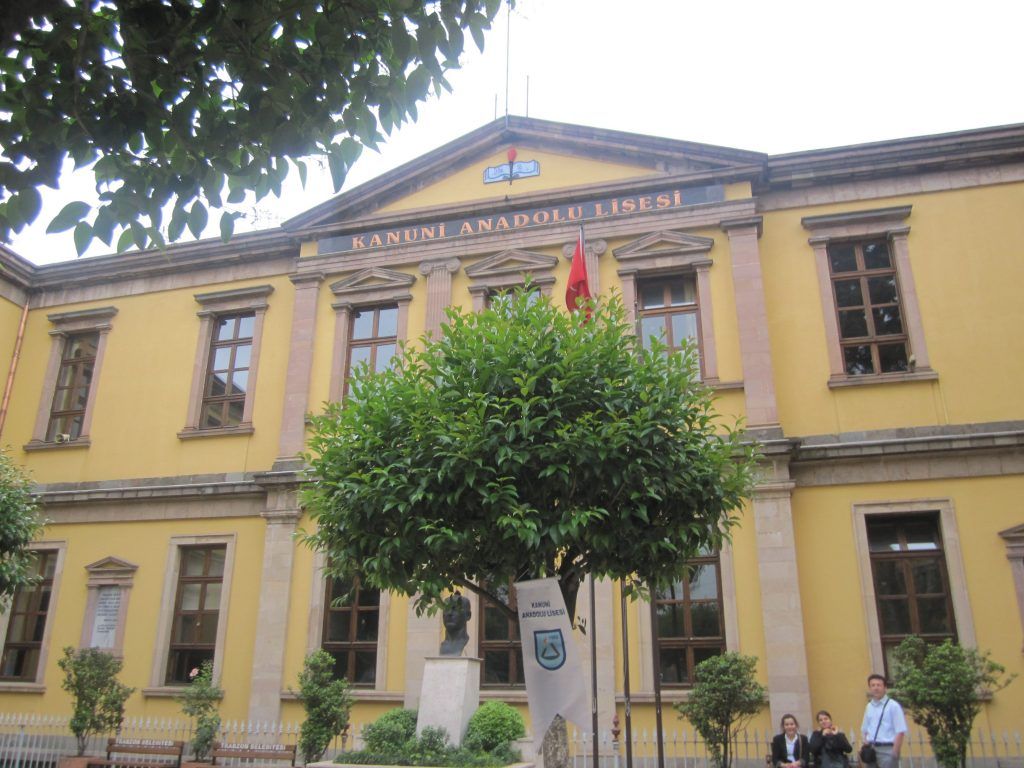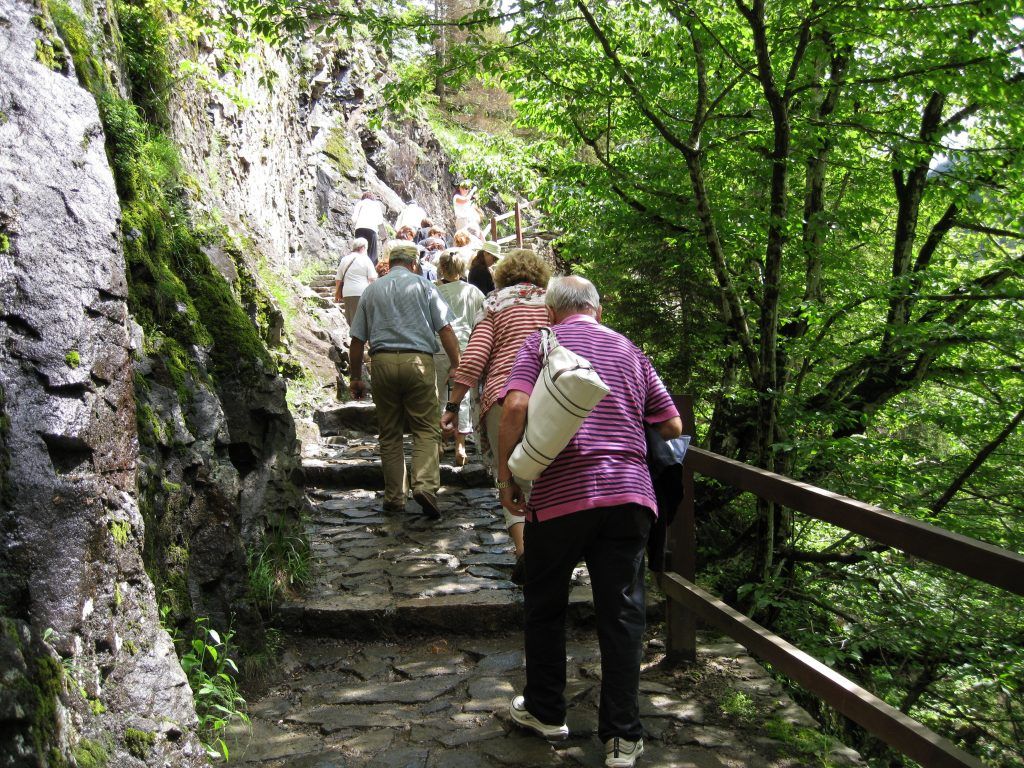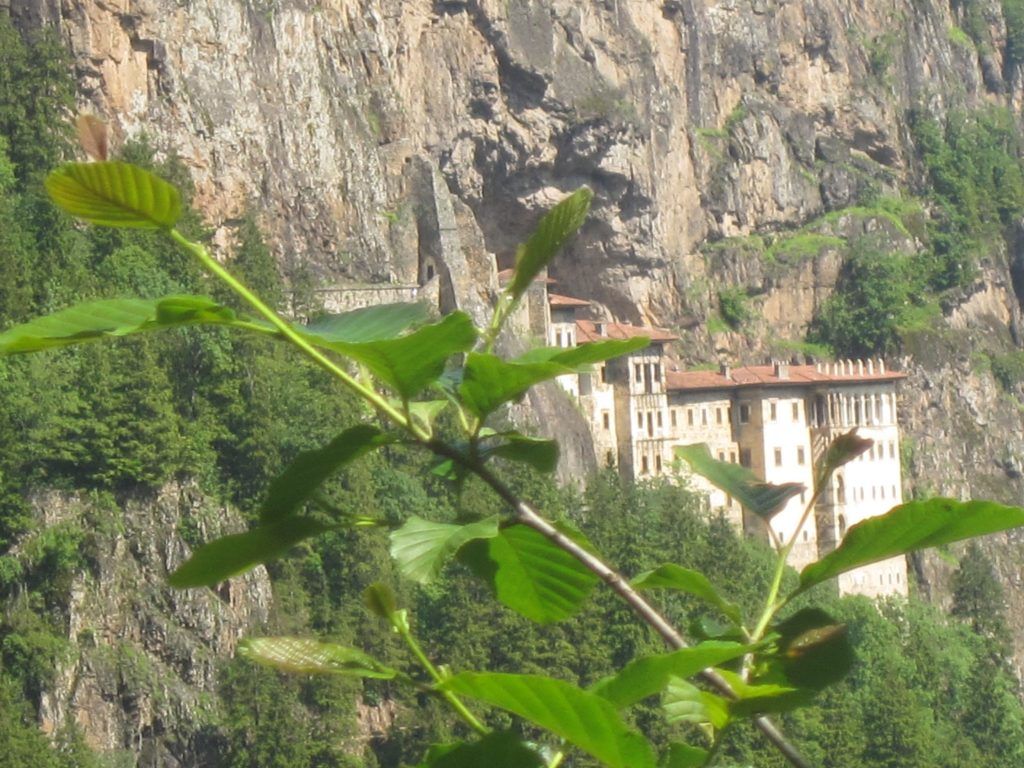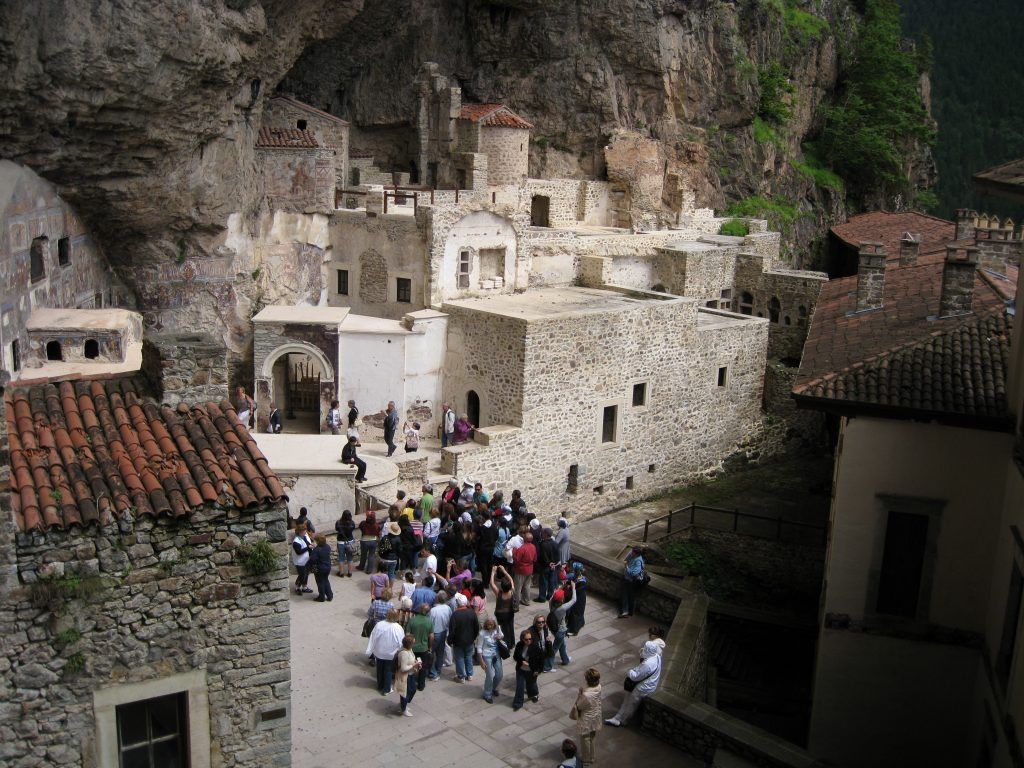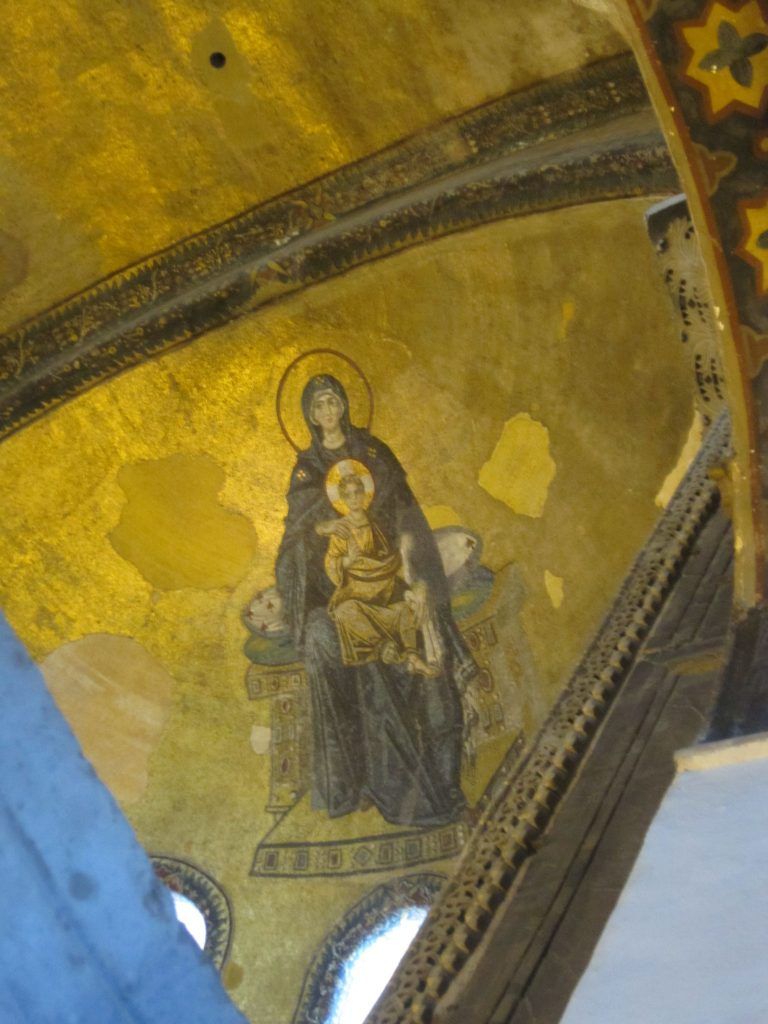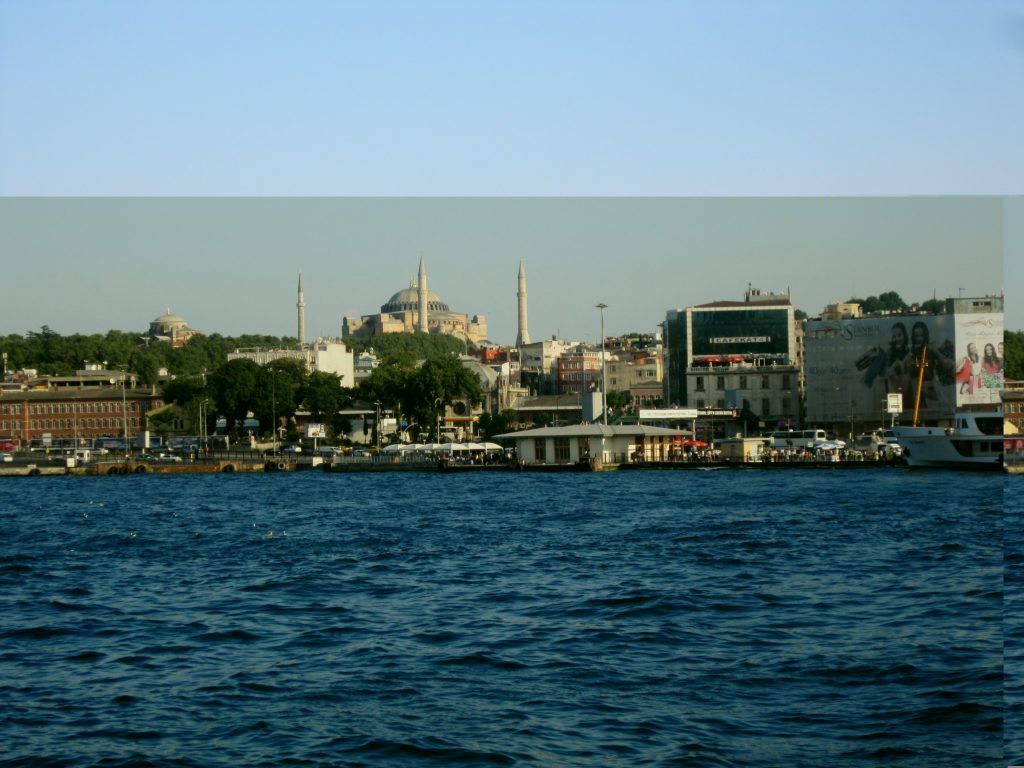Mission to the streets of the East
(June 22nd-30th 2011)
Trip to Cappadocia and the Black Sea
Cappadocia-Samsun-Trebizond-Mother Mary of Soumela
A trip to the unforgettable homelands of Cappadocia and the Black Sea
100 people participated
A journey to the unforgettable homelands of Cappadocia and the Black Sea can only mark an exciting journey. It is the match of the oriental aura, the Greek tradition, the intense historical experiences of our race and orthodoxy that leave their testimony to these beloved places everywhere.
My long-lasting desire to visit-pilgrimage these places was fulfilled by the Foundation of Ecumenical Hellenism with the journey they organized from June 22nd-30th 2011 in Cappadocia and the Black Sea Regions.
The journey starts with an unexpected scene for the season. Upon arrival at Kayseri Airport, we faced a snowy mountain. Our guides, Ekrem (from the Pomak villages of Ksanthi) and Sophia (one of the remaining Greeks of Constantinople) are not slow to explain that the Argos Mountain, standing before us, is a volcano, always snow-covered and in addition with the other volcano, Hassan, one gets how the landscape throughout Cappadocia is created.
Searching for information about Cappadocia, we are informed that there are many opinions about the etymology of the name (Cappadocia), with the prevailing one being that the Greek name has its roots in the Persian Catpatouka, ie the country of the beautiful horses. In fact, in our tour we met scattered horse statues that advocated this opinion.
Cappadocia is one of the largest areas of East Asia Minor, and the first of the historians to mention it is Herodotus. Its inhabitants, the Cappadocians, must have settled there, after 1600 BC, when it was still the Hittites state, with its capital being Hattusa (where most monuments were found). Their submission followed to the Persians, the Macedonians and the Romans. Alexander the Great respected the autonomy of Cappadocia and kept it until his death, when his successors captured it and gave it to Eumenes (322 BC). In 315 BC the city was captured by Antigonus the Monophthalmus, but after the battle of Ipsos was subjected to the Seleucid state. It quickly regained its autonomy. Later, Mithridates VI of Pontus clashed with Rome, conducting three wars (Mithridatic Wars). The Romans then seized the Cappadocian state by changing it into a Roman province. Mark Anthony gave the throne to Cappadocian Archelaus, a scholar and writer.
In the 1st century AD, the Hellenization of this region is complete. In this spirit, remarkable centers of Christianity such as Caesarea, the first in the hierarchy and prestige of the Metropolis of the Patriarchate of Constantinople, are situated. Well known cities that are famous at this time are: Ariathamia (on the Saros River), Tavia (Gozgat), Nissa, Mokisos (on the River Aly), Arabisos, Colonia, Iraklia and Nazianzos. In the 3rd-5th c. education and literature flourish. In Cappadocia, the great Fathers of Church, Fermelianos of Caesarea, Gregory of Neo Caesarea, Leontius and Eusebius of Caesarea, Basilios the Great, Gregory Nazianzinos and Gregory Nissis (brother of Great Basilios), can be distinguished in the sanctuary. The power and enforceability of the Metropolitans of Caesarea was so great that they were leaders in every political and religious movement. The purpose of each Metropolitan was to promote the literacy and sensual institutions, making all of Cappadocia a fast center of all religious and educational action, preserved for centuries. At the times of Great Constantine, Cappadocia was united with Pontus and constituted a small state. The emperors of Byzantium, recognizing the strategic position and importance of the country in defending the empire, made it a great military center. Also, in Cappadocia, Justinian won the army against the Persians and Heraclius when he defeated Khosrow II (623). Eventually, however, he succumbed under the weight of repeated Arab attacks. Cappadocia was recaptured by the Byzantine Empire in the 10th century.
In the late 11th c. Cappadocia was subjected to the Seljuk Turks and in the 13th century, to the Ottoman Turks. After the occupation by the Ottomans and because the country was not so fertile, the immigration of Christians began with three main outposts: towards Mersin and from there to Alexandria, to Constantinople and Smyrna and to Amisos. In time and with the development of transport in Asia Minor, a series of thriving communities began to emerge along the above routes, from which came great merchants, bankers, even government officials, the well-known Kayserlides. In the nineteenth century a new beginning for the Greek-Christian element and the Greek studies began in Cappadocia.
On our trip to Caesarea, the city of Saint Basilios, we were impressed by the imposing Byzantine castle (Ic Kale) of Justinian. Searching for the traces of the famous “Basilica” of this charitable state founded by the great Saint Basilios, bishop of Caesarea, we were given an area on a hill very close to the city, traces that do not survive today. In the Caesarea’s market (consisting of a closed and an open section), where our noses led us, since the smell of pastrami was particularly intense. In our tour we also came across the first orthodox church of our trip, Saint Nikolaos. The cross of the dome was missing and today’s use is … a gym! Full of images of the first day, we took the road to Ugrup-Saint Prokopios, as it is mentioned in the Episcopal lists of Leodos Sofos – where we would also stay the night.
During our tour, on the second day of the trip, we saw that Cappadocia is an endless museum of natural lava sculptures. Nature is the creator: the volcanic hills, the rocks that emerged, and especially the soft limestone, the erosion from the harsh weather on the plateau and the absence of wood. Human part: With the toughest volcanic rocks as tools, with art and passion, they were led to dig caves to use as homes and for protection. Protection from each race of raiders who, over the centuries, crossed and looted Asia Minor.
Some of us enjoyed the exciting experience of sunrise, flying with hot air balloons over these volcanic formations.
Our visit to Goreme left us speechless, as we found ourselves in front of a great monastic state of churches carved into the rocks. St. Zoumboulakis, Director of the magazine “New Hestia”, in a speech of his at the Center for Asia Minor Studies (21-6-2006), informs us that “… one of the treasures of this place (of Cappadocia) the most precious one, is that there are more than two hundred Stately churches – others are yet to come to light – which, divided into three large groups, are geographically distributed as follows: a. Goreme valley, second valley of Soganli and third valley of Ihlara “. Crossing the Valley of Goreme, we found ourselves in front of dozens of Byzantine churches, chapels and monasteries that gathered the faithful up to the 13th century. The existence of banquet facilities in many of them testify the beginning of organized monastic life. G. Lorenzatos, prefacing in G. Seferis’s book “Three Days in the Monasteries of Cappadocia”, writes: “Almost everywhere on the walls of the stone-built monasteries, there is an inscription” Lord help! “. The years of St. Basilios fall in the 4th century AD. and the raids continue for many centuries later. In difficult times, the monks clog the doors of the monasteries with thick stones. Waves and waves are hitting Cappadocia from everywhere, the wild and abducting occupiers with all the means of that era … and the faithful have nowhere to escape except in caves and the earth. As soon as one riot calms down, another one immerges, and another..and another…”.
We visited a number of churches, which were given unusual names. Ekrem, our companion, informed us that the church, which had Archangel Michael in the hagiography holding the world, was called “The Church of the apple tree” because it was believed that the illustrated globe (world) was an apple. Similarly, the churches of “the snake”, “the Sandals”, “the Stephans”, “the Swords” were named after the same way of thinking. Mural paintings-frescoe paintings are preserved in a very good condition, all known hieroglyphic “circles”, that show the events of the life of Christ, the Virgin Mary and many saints. We were impressed by the “Dark Church,” whose hagiographies are better preserved, having a particularly bright blue color, with a variety of performances. After his victory over the Arabs, Emperor Nikiforos Fokas built a carved church, which we also visited.
Continuing our journey, we traveled through Aly, the longest river in Asia Minor, and our team leader, Ekrem reminded us of the history of Croesus and Solon, that is associated with the region. On the banks of River Aly is a beautiful Byzantine town, Avanos, which is famous for its pottery. We saw the relative potter’s monument.
On our way, we saw the impressive Uchisar, the huge rock that looked like a hive from a distance, with its numerous dwelling caves. We took a moment to admire the landscape and take commemorative photos.
Our tour, on the same day, ended with our visit to the city of Mustafapasa, an ancient Byzantine town, with distinctive signs of Greekness and Orthodoxy. Many mansions with Greek inscriptions and two well-preserved churches (Saint Constantine and Helen and the Great Basilios) reveal the thriving Greek Hellenism of the city. We passed through the Temple of St. Constantine and Helen, who was also a metropolitan, a three-aisled basilica built according to its inscription in 1729 with many decorative elements in its interior and exterior. Opposite the church is preserved, not in a good condition, the house of the priest, whose façade (as in many other Greek houses) had carved Byzantine figures around the doors and windows. We visited a Greek mansion that the current owner has transformed into a hotel and a restaurant, we went up to the rooms with the old short tables, the beautiful paintings, the colorful ceilings, and out in the yard, facing Greek houses around us, we drifted in to the past. How would life be when all these mansions were in their prime? We were confused by the smell of the flowers in the pots with that of the Asia Minor Greek cuisine and the white-washed clean curtains on the windows! How many stories we have heard, how many we have read, about the housekeeping and the fortunes of the women in Asia Minor?
The third day of the trip was equally impressive. Passing from Nevsehir, the capital of Cappadocia, we were informed about the existence of a church for the Assumption of the Virgin, which was used as a prison from 1924 to 1982 when a prison building was built in the area. We passed from the city of Gora, which was never inhabited by Turks because they considered it a haunted ghost town because of its violent abandonment by its Greek inhabitants.
Our course continued towards Malakopi. From the etymology of the word we came to safe conclusions about it. Mala + kopi means is a lot of trouble. Indeed, due to the frequent raids, the need raised, for each home to have another space under that like a basement, so that the family could remain safe until the danger expired. Over time and because staying in these underground areas lasted long enough, the underground houses were joined using corridors, resulting in the creation of underground cities. We learned that in the area of Cappadocia, 36 underground cities have been found, which are considered as constructive wonders. Some have up to 8 floors that were created progressively. We saw the point from where the central airway started which went up to the top floor and communicated horizontally with each floor separately, in such way that oxygen could be ensured in every space. Therefore, the residents were safe in the underground cities for as long as the raids continued. The temperature is the same in winter and in summer. Many of us went down 30am while the most courageous attempted descent to 80m. In any case it was a special experience. Going down to the first floor, we came across animal stables, which reasonably existed on the first level, considering the difficulty to move big animals and the stench of their impurities. On the lower floors, except of the houses, we came across wells, meeting rooms, a church and even a cemetery.
Before we left Malakopi, we were given the opportunity to visit the temple of Saint Theodore. We were impressed by its size, the Armenian influence on its art and the elaborate embossed vine on the main entrance. In its interior, we experienced abandonment: birds were flying over our heads, broken wooden walls and rotten floors, faded images and rubbish all around. Two hagiographies in a better state of the Annunciation and the imposing form of Jesus Christ in the dome, managed for a while to eliminate our bad feelings.
The journey continued through Kaymakli, place of origin for a traveling companion, who stayed for the rest of the day there, searching for the home of her ancestors. Her only supplies were an old photograph and her grandmother’s information, which is no longer alive. I must mention here, that amongst us there were many who sought their roots in Cappadocia or in Pontus, following this journey not for pleasure but mainly for a pilgrimage-promise to the birthplaces of their ancestors, a fulfillment of the due honor on the part of the younger generation to their forefathers. We thank those fellow travelers for allowing us, even for a while, to share their emotions and experiences.
On the third day, we fulfilled a tour to the Ihlara Vadisi with its dozens of churches and beautiful nature. We walked down the 380 steps leading to the gorge, walked along the river Melendi and worshiped the ascetic of St. Gregory the Theologian and the other cave churches that existed there.
The third day was completed by our visit to another wonderful Greek city, Guzelyurt, the most important town in the southwest of Cappadocia. The temple of St. Gregory of Nazianzenos has unfortunately, been turned into a mosque. The relic of the saint, which used to be there, is now kept in Nea Karvali in Kavala, where the Cappadocian refugees transported it with the exchange of populations in 1924. We also saw the Greek girls’ school, which today operates as a hotel. The energy of the active Greek community in the region cannot be hidden behind the neglected “face” of the present city. An encouraging fact for the future of the city of Karvali is its recent establishment as a preserved city. Leaving behind the Karvali Hills, we are in front of an idyllic landscape. A magnificent lake, and next to it a hill, at the top of which dominates a church, the Catholic of the once Holy Ascension Monastery.
On Saturday June 25th, our road trip from Cappadocia to Pontus was scheduled. Before leaving, however, we passed by the stable where St. John the Russian lived after his capture by the Turks. Soldier of the Great Tsarist Army of Russia, St. John, in a fight to defend his homeland, Russia, is captured and led to Constantinople and from there to Prokopi in Cappadocia. He suffered physical and mental torture with remarkable bravery, until he finally became dear even to his persecutors. Eventually he died, after the hardships he had suffered. The miraculous relic was carried by the faithful to Greece, with the exchange of the populations and since 1925 it has been kept in Neo Prokopi, Evia, where a sacred temple was built in his honor. In the old Greek Prokopi district in Cappadocia, with the cave houses, the stables that St. John was living in, as well as the bed he himself carved in the wall, are preserved.
As far as the modern town of Prokopi is concerned, it is particularly well-preserved, with paved tiles, many flower beds and a beautiful square, in which there is an old Greek church which today, unfortunately, functions as a hamam. As we were walkinging the streets of Prokopi we saw nice shops selling: tea in various flavors, decorations of the Cappadocian volcanic landscape, nuts and spices. Cappadocia is particularly known for its carpet industry, that’s why we saw so many carpet stores. It was easy to see, looking in windows, the craftsmen crafting the famous handmade carpets.
With our suitcases full of “impressions” and “feelings” we left Cappadocia and traveled about 8 hours by coach to Pontus.
Our destination was initially Samsun, the Byzantine Amis. The Euxine Sea or Black Sea (Kara Deniz) was impressive. It was named Black Sea (hospitable sea) euphemistically, in fact Axenus, because it has always been wild and stormy. It is large closed seashore between Europe and Asia Minor. Around the Black Sea are Russia, Romania, Bulgaria and Turkey. It connects with the Mediterranean Sea via the Bosporus and the Sea of Marmara and the Azov Sea through the Kerch Ishma. The water was brown because of the rivers that end there from all the around countries.
Samsun, the home of mathematicians Dimitrios and Dionysodoros, was initially named Amisos by the inhabitants of Miletus in the 7th century BC. Etymologically, the term derives from the expression “in Amison, S’Amison, Samsun”. Later Amisus belonged to the Kingdom of Pontus, which was later part of the Great Alexandrian Empire. In 47 BC, it became property of the Roman Empire, in 1200 AD the Seljuk Turks took over and finally in the 15th century it became property of the Ottoman Empire. It was the most commercial harbor on the southern Black Sea coast, a transit trade center, with rich cereal and tobacco crops. In the middle of the 19th century, 60% of the tobacco trade was in the hands of the Greeks, making them, along with the big merchants, the richest among the inhabitants. The rest of the Greeks were shopkeepers, craftsmen, doctors, lawyers etc. We found ourselves in front of the ruins of three tobacco factories in the city, which, as we were told, will be restored after a permit issued by the Municipality of Samsun. Its population is about 400,000 inhabitants according to the 2004 census.
During our tour of Samsun we walked to the Greek area and saw old mansions, others preserved and others not. Chinekio, a well-preserved school complex, that was used as a school for boys only, girl only and a kindergarten. The complex had the famous temple of the Holy Trinity, which, however, has been destroyed from its foundations. The Philharmonic Orchestra of Samsun was famous. We walked through the Clock Square and finally headed to the Archaeological Museum of the city.
Approaching the indoor market of Samsun, we were surprised to see a huge poster that covers one side of the building. It presents Samsun in the early 20th century and Kemal. At the bottom of the poster there is a clear reference to May 19th 1919, when Kemal Pasha (later named Ataturk, meaning ” Turk Generator”), an officer of the Ottoman army, disembarked at Samsun with the mandate to protect the Ottoman residents, meaning also the Greeks and the Armenians, from the massacres of the army. Instead, Kemal became autonomous from the central government and created the nationalist movement, whose main concern was the repression of the Pontiac guerrilla. After the Balkan Wars and especially with the beginning of the First World War, the Ottomans’ decision to finally resolve the national problem of the Empire with the natural extermination of indigenous ethnicities began gradually and through various means, being realized. It is reported that Amisus paid the highest blood bill, since nine missions of mass displacement were carried out until September 1921, which together with the alleged Amasia Courts of Arbitration, led to their spiritual and economic extermination.
The second day of our trip to Pontus was dedicated to the martyr city of Amasia. Amasia is a beautiful city 70 km south of Samsun, built on both banks of the river Iris. Homeland of the ancient Greek geographer Strabo, whose statue we saw on the banks of the river. In the same area, there were massive busts of sultans who attended the Amasia schools. There was the temptation to send the children of the sultans, the princes, to get high education and a selective administrative experience. The sources report that at the beginning of the 20th century, the Greek element of the area numbered 155,000 inhabitants in 392 parishes with equal churches and 325 schools where 10,000 students attended and 565 teachers taught. It was also the head of the Metropolis. The name of this city has been linked to the terrible torture suffered by the Turks by the Greeks of the Pontus in prison. Between January 1921 and 1923, hundreds of Greeks, many of them distinguished in the economic life of Pontus, passed from the so-called “white cells”. In September 1921, teachers and students of the Hellenic American College of Merzifounda were hanged. On the same day, Turkish courts condemned to death, without apology, 180 other Pontiac Patriots. More than 70 people were hung from the Turks in the central square.
The carved tombs of the Mithridateus Kings on the slopes of the mountains north of the city, are impressive. We visited the archaeological museum, walked through the old Greek neighborhoods, with the “ghost houses” and finally took the opportunity for tea and souvenir shopping. The city’s population today is about 80,000.
The next day, we set off for Trabzon. An impressive journey along the Black Sea coastline, with the rough sea on our left and the verdant landscape on our right, combined with the gray sky of Pontus – that as we found out, is like that 300 of the 365 days of the year.
We met the homeland of the Amazons and the Black Sea, which was near the river Thermodontas. On our way we came across Unye, Fatsa, and visited Yasun burnu. Jason on his way to Kolchida (today Georgia) may have found a storm in the alien sea and rested in this cape. Here he built a temple dedicated to Zeus. Later on the Monastery of Saint Nikolas was built o these ruins, the monks of which have undertaken the commencement of the maintenance of the adjacent lighthouse. Nowadays, the deserted church of Saint Nicolas, which we were allowed to enter, is preserved. Close to the temple there is a newer marble slab with references to the Argonautic Campaign, which portrays Jason grabing the golden fleece.
Afterwards we stopped at the known by the Descendants of Xenophon, Kotiora (Ordu). During our visit to the temple of Ypapanti I personally experienced some of the most moving moments of the trip. In the front of the temple, there were photographs that referred to earlier times when the church was used as a prison. Moving into the main part of the temple, our hearts began to strike stronger when we saw a hall of events and a piano in the place of the Holy Trinity.While on the sides of the sanctuary, where the icons of Archangels Michael and Gabriel prevailed, a huge Turkish flag and a poster of Kemal Ataturk. With such a disappointment, we walked out towards the yard when an unexpected scene was awaiting us. A poetic lyricist gulled our sorrow with his melodic Pontiac lyre. In our effort to manage the mixed feelings of joy and sadness, a sympathetic, obviously excited fellow traveler, who was from Kerasounta spontaneously started dancing. Immediately he was followed by others, composing a unique setting that surely stayed deeply engraved in our memory: the lyre player sitting on a bench in the courtyard of the temple, a team of tearful dancers, a crowd of excited people clapping at a pace, while in front of us a beautiful seaside town, and the Black Sea. Later on, we walked to the old Greek town and saw the Polycarpio School.
After our trip, always on the coastline, we visited Kerasounta
(Giresun). We generally heard that the name comes from the cherries that thrived in the area, but from our guide we heard another version, that it was named after the city’s shape that grows like a horn on the Black Sea coast. In Kerasounta, which was founded in the 2nd century BC, there is a Byzantine castle, while at the bottom of the harbor we see an islet known as the Amazon Island. In the 19th century, it became the economic center of the region, relying mainly on the trade and cultivation of hazelnuts. We visited the church of St. Nicholas, which operates as a museum. Next to it there was a storage room for the needs of the church and opposite, the house of the priest. In the mist, there was a girls’ school nearby. Kerasounta, a city with a naval tradition, had a number of major ship-owner companies and bank branches: Ottoman, Athens and Georgios Pissanis.
We continued our journey through Tripoli (Tirebolu) and Akcaabat to reach Trabzon. We recalled the descent of the Ksenophonian Myrians, and in particular the army of the Spartans, when, after 18 months of exhaustion, returning from Kounaksa, traced the sea of Trebizond and shouted: “Thalatta, thalatta”.
The historic capital of Pontus, Trebizond, owes its name to the trapezoidal shape of the hills on which it is built on, at the northern foothills of the Alps. It was founded in 756 BC, as a trading station in Sinope and has enjoyed great prosperity until its conquest by the Romans. During the reign of Emperor Justinian I, it becomes of particular importance, as it becomes the basis of the Byzantines in the Black Sea Region in their struggles against the Persians. At the same time, both in the city and in the wider area of Trebizond, walls and an aqueduct are being built. In the 7th century in his autobiography the Armenian Ananias Sirakinos informs us that at that time the city was a major spiritual center with a mathematics and astronomy school. In the 10th century, the commercial importance of Trebizond takes off and the city becomes the prime destination for the merchants of the precious commodities (silk, myra and paints) of the East. Fifty years later, after the Byzantine defeat in Matzikert, in 1071, Pontus was severely challenged by the persistent Seljuk attacks and the city had to be found for a short time in their possession. Saint Theodore Gavras was a general and liberator of Trebizond, establishing independent hegemony. In 1098 he martyred in Theodosioupolis for the Christian faith. The Gavras family will dominate the political scene of the region during the critical period until the end of the 12th century.
After the fall of Constantinople by the Franks (1204), the Komnenos state was established in Pontus, the city known as the Empire of Trebizond and its symbol was the one headed eagle. Its founders were the grandsons of the Byzantine emperor Andronikos I Komnenos, Alexius and David. The end of it, however, came in 1461 when David Komnenos delivered the city to Muhammad II. The city still retains its medieval character, as large parts of the walls and the Great Komnenos Palace are preserved.
Among the most famous of Pontus, who excelled from the 13th to the 16th century, were Bessarion, Georgios Amiroutzis, Georgios Chrysokokis and Gennadios the Trebizond.
The 19th century was a period of impressive growth for Trebizond in the fields of economy, education and community organization. The city had a theater, three cinemas, and the Greek community had a large nuber of social organizations and associations. At the beginning of the 20th century the population was estimated at around 50,000 (15,000 Greeks, 4,000 Armenians, 600 Europeans and the rest, Turks). During the First World War, in 1916, the city was occupied for almost two years by the Russian army. At the same time, the presence of many diplomatic missions prevented the new-Turkish plans of persecution. In addition to the metropolitan throne of the city, there was a great hierarch, Chrysanthos Philippidis (1913-1925), later Archbishop of Athens (1938-1941), who played an important role in one of the most critical periods of the Pontiac Hellenism and, on the other hand, as a top ecclesiastic man for his spiritual work and ethos. The appreciation of the Turkish authorities towards him and the prudence with which he ruled Trebizond during the Russian occupation prevented reprisals against the Greeks when the Russian troops left the city in 1918. Later, however, the Pontiac element along with Hellenism and the element of Asia Minor underwent terrible persecutions. The results of the war, which must have been counted and mistakenly manipulated by metropolitan Greece, were known in our collective memory as an Asia Minor Disaster, which was sealed with the Treaty of Lausanne (July 24, 1923). As far as Pontus is concerned, the Hellenic Parliament unanimously in 1994 recognized the genocide of Pontian Hellenism and established it as a day of remembrance on May 19th. According to the historian Costas Fotiadis who studied the archives of diplomatic missions in Pontus “out of the 697,000 Pontiacs who lived in the Pontus in 1913 more than 353,000, more than 50%, died by 1923 by the Turks and the Kemalists in towns and villages, exiles and prisons, labor battles, the so-called “amele tabourou”, which were death battalions. ”
Walking through the city of Trebizond, we passed through the church of Saint Anne. It is the oldest church that is preserved in Trebizond, but cannot be visited. A three-aisled basilica of the 7th century that, according to an inscription above the entrance, was renovated in 884-885 by the Byzantine emperor Basilios A. We were informed that it is used by the Municipality, mostly believed, as a warehouse.
In the list of the city’s sights, we should not leave out Gülbahar Hatun’s mausoleum. Gülbahar (the Spring of Rhodes) was Greek from the village of Libera of Pontus, known for her exceptional beauty, which later became husband of the sultan Bayezid II.
The walls of Trebizon are still preserved in a good condition despite the great disasters they have suffered over the years. Their story is interwoven with that of the city. The walled city consists of three sections distinctly different from each other, a phenomenon particularly common in Byzantine cities. The upper part, the acropolis, the Byzantine Castle, usually enclosed the city’s administrative center. The Middle, Upper or Middle Country was the residence of the rulers, while the third, lower section, which was usually tilled later, after population growth, was intended for the rest of the city’s inhabitants. Going from “Exokastron” to the middle city, one finds himself in the area where the temple of Mother Mary Chrysokefali dominates, which we visited. Built on an ancient Roman temple, it has been converted into a mosque since 1461 and was the metropolitan temple of the MegaKomninoi – where the emperors’ coronations were also carried out.
Nearby, outside the walls of Trebizond, is the Church of Saint Sophia (13th century). Composite cruciform engraved with dome, narthex and three impressive propels. The bell tower dominates. It was built by Manouil Komninos in the area, where once the ancient temple of Apollo existed. In the exterior dominates the one headed eagle, emblem of the empire. Indicative of the beginnings of the new Empire of the Komninoi, as part of the hagiography, are at least two representations of Christ in the temple. The way in which the elements of architectural shaping, painting, mosaic and sculpture decoration are combined could be described as unusual and perhaps unique because of the coexistence of disparate influences from the West and East. Part of the mosaics and hagiographies of the church’s main worship space have been preserved to this day. Literary sources of the 14th century mention “the monastery of our Lord Jesus Christ, the Saint Sophia”. The funerary function of the monument is evident in the formation of the monument, which is presumed by the burial niches and tombstones housed on the temple’s precinct.
On the hillside of Trebizond there is a green suburb, Kryoneri. There we were impressed by the Kapayannidis villa. We went up to the two floors of the building with the many rooms and we admired the beautiful overlooking, colorful of the varieties of flowers, gardens. We had the pleasure of a descendant of the Kapagiannidis family accompanying us. Afterwards we visited the mansion of banker, Kostas Theophylaktos. A special scene was carved in my memory: the wonderful dance hall with the beautiful, elevated space for the orchestra and the imposing glass vault, which discreetly allowed the light to diffuse, giving a dreamy, and fairy tale sense to the room.
During our tour in Trebizond, we were particularly impressed by the “Hellenic School of Trebizond”, also known as “Lighthouse of the East”. As a school, it began to function during the first centuries of the Turkish slavery, which, although it did not have a prominent position, was the only one in the whole region. By the time, however, its recognition began, it was renamed “School” and together with the Evangelical School of Smyrna, it was the most important school of its time. In this institute, great teachers of the time, such as Trebizondus Sebastos Kyminitis, Savvas Triantafyllidis, Savvas Konstantinidis, Iraklis Triantaphyllidis, taught in the 17th century and great personalities of the history of Pontus and of Greek history in general studied, such as the Pontius of origin, Ypsilandis. It operated in spite of adversity until 1922. Its contribution was very important in terms of the intellectual and moral rehabilitation of the Hellenic Pontius, the training of competent teachers for the communities there, and especially the development of their national consciousness.
Trebizond now numbers some 200,000 inhabitants. The technique of silversmithing is known. We were in stores where we were able to watch the special way in which, as if they were knitting and embroidering, craftsmen made sophisticated bracelets, necklaces and earrings with silver. In the streets of the city one can meet textile shops, many groceries with fresh cow butter, kefalotyri and others. (Trebizond is famous for its livestock breeding).
This wonderful journey was slowly coming to an end. It was time for our pilgrimage to the monastery of the Mother Mary of Mount Mela. Many of us traveled to fulfill a craving, perhaps, a vow to Our Mother Mary, and along the way we experienced the unexpected. In the Matsukas province, in a verdant valley leaking from the Pyxitis River is the Holy Monastery of the Most Holy Soumela. It is covered with dense forest with various types of trees: walnuts, spruce and pine trees, from which the Pyxitis river is named after. Reading a relative article by Archimandrite Pavlos Apostolidis, former abbot of Saint Mary of Soumela of Vermius and nowadays Metropolitan of Drama, we learn: In 386 the monastery was founded by the Athenian priests of Barnabas and Sofronios, after the revelation of the Virgin Mary, which encouraged them to follow Her image On Mount Melas of Trebizond and to establish a monastery. The icon has, according to tradition, been made by Evangelist Loukas. After the Evangelist’s death in Thebes, Ananias’s disciple brought the icon to Athens, to a temple that was destroyed by fire in 1885. The icon of the Athenian Mother Mary flew from the temple and was carried by two angels to Mount Mela. The saints Barnabas and Sofronios followed the picture, arrived in Trebizond and climbed to mount Mela, where they discovered the holy image in a cave. The two founders of the monastery lived until the year 412 and died on the same day. Already, from the very first time of its foundation, the monastery was a great place of pilgrimage for Christians, later for the Muslims of Pontus, for all Asia Minor, Russia, and for the rulers of Moldavia. The emperors of Trebizond, the Komnenoi, showed special reverence for the monastery. Ecumenical Patriarchs secured it’s rights and Ottoman sultans provided donations and secured privileges. In 1923, after the expatriation and desolation of the monastery, manuscripts and sacred relics were seized by the Turks, forbidding the monks to take anything with them. The Turks caused irreparable damage to the monastery’s buildings and frescoes. From the sacred relics, three most important were rescued: the icon of the Virgin Mary, the Cross with the Holy Wood donated to the monastery by the Emperor Manouil III and the Gospel of St. Christopher. During the expatriation the monks buried them in a corner in the chapel of Saint Varvara, near the Monastery, which remains are preserved until today. In 1931 Archimandrite Ambrosios Soumeliotis, in charge of the Fund of Inland Community and Public Benefit Reliefs, found the sacred heirlooms and transferred them to Athens in 1931. By order of the Ecumenical Patriarch they were temporarily placed in the Byzantine Museum. In August 1951, the icon of the Virgin Mary was transferred to Mount Vermius, above the community of Kastania and the foundation stone of the temple was placed, which was completed in 1952. Later, the other two heirlooms were placed in the monastery too: the Holy Cross and the Holy Gospel. In June 2010, the Turkish State authorized the Ecumenical Patriarchate to celebrate the Feast of the Assumption (August 15th) after 87 years, as it has been converted into a museum. The Patriarchal Holy Liturgy was repeated.
To approach the monastery, we had to board small buses until a certain point and then walk for a while. We were compensated by the wonderful verdant scenery, but especially when, at last, we got to the monastery. Our excitement could not be described and we thanked the Virgin Mary for stepping on those holy grounds and for the wonderful weather we had that day (as mentioned above, the sky in Pontus is usually dull and rainy). We admired the remaining internal and external hagiographies, the surrounding area of the monastery, and we saw with awe the holy water through the giant rock.
We sat down to rest next to the river and continued our way east of Trebzon. We visited Surmene and climbed the Pontiac Mountains to the Pontiac Serpent (Uzungol). Surprised, we found ourselves in front of a beautiful scenery that reminded of a painting: green mountains surrounded by a river with plenty of water and scattered bridges that ended up in a dream lake. We took great pictures and ate trout in the restaurants there. Several of us, found the opportunity to chat with locals who insist on speaking Pontiac and were photographed with them.
In the afternoon we returned to Trabzon and from there the following day we would return via Istanbul to Athens. Some took advantage of their long stay in the City and admired all of the attractions they had come to visit.
The journey had come to an end. Left with the dizziness of our impressions, we were filled with experiences, knowledge and thrills. Following the steps of our ancestors, the streets of the turbulent history, the paths of emotions, we took a fragrance of the east with us and promised that we would not forget the struggles of our ancestors in the name of Hellenism and Orthodoxy. We left behind, at the holy ground of Cappadocia and Pontus a piece of ourselves, perhaps the most true and authentic part and committed to pass on the fullness, satisfaction and happiness that this extraordinary experience of traveling gave us, and perhaps repeat it in the future.
Speech by Michalis Charalambidis at the Pontiac Genocide monument in Philadelphia, USA
(Michalis Charalambidis “The Pontiac Issue of Today – The Pontiac Problems in the UN”, STRAVON Publishing, Athens 2005):
“In our mythical world, Pontus is alive with Prometheus, the Argonauts, Jason, the Amazons. According to the Greek conception of the beginning of the world, it is one of the components of its creation. In our historical world it is alive with Greek cities – Sinope-Amisus – Trabzon – Kerasounta. This Mithridateus Kings of Pontus (Mithridateus the Eupatorium placed a statue of Plato in the Athenian Academy that the great philosopher himself created in Athens). These Komninian Emperors of the kingdom of the Trabzon (1204-1461). These Ypsilanti’s leaders of the Hellenic and Balkan Revolution against the ethnical parasitic feudal regime of the 19th century… For centuries, Pontus was the Economic and Commercial and Cultural Center. Philosopher Diogenes that gave us the word “cosmopolitan”, the Geographer and Historian Stravon, savior of Greek classical literature, of books on Ottoman – Islamic totalitarian barbarism and great father of European and Western civilization Vicario were Pontiacs.
Pontus was a model of harmonious relationship between the natural, human and architectural landscape. Among the people, the cultures, the humans. This harmony has been violently disturbed by concrete ideologies. This historic cultural core was murdered and thrown into re-development. That was the Turkish conquest, the Sultan regime, the most barbaric regime that Humankind met. The final blow, however, was given by an ideology of death which is represented by Kemalism. Even now, every person of Asia Minor knows about this genocidal lasting racism.
Pontus today, consists of ruins of churches, monasteries, palaces, government buildings, homes, schools, villages, towns, castles that have been the eclectic creations of the world’s civilization. If they hadn’t been destroyed, they would have been more beautiful than Tuscany, Burgundy, and Andalusia. However, the Sultan Turkish Islam was very different from that of Andalusia, it was barbarous and devastating. In no part of the world do you meet so many destroyed monuments. The Taliban used to exist here from time to time killing people, they were more barbaric and in the past century they had the support of both Europe and the Soviets. An immoral alliance.
Within these ruins, one can meet the last guardians, the descendants of this civilization, which after the entire racist devastating catastrophes, insist in speaking the closest language to Ancient Greek, spoken today. They are the great inhabited population of the Islamized Christians and even crypto – Pontiacs who remained in Pontus.
Through the ruins, the melancholic and, at the same time, sweet fiches of young children are revealed and answer to the question: “Who is your mother and father?” They respond as if they were children of Homer’s time. “My mother answers to Aise and my father to Muhammad.” Homer wrote: “The name he answers to is Achilles, Odysseys, and Aiantas.” He does not write: they call him Achilles. The modern Turkish state denounces the existence of this ancient language.
This was the response of the Turkish representative to the United Nations, Altay Genciger at our intervention towards the Human Rights Committee of the Organization (February 2002) concerning the rights of the Islamized Pontiacs in Pontus today.
They are killing instead of protecting a language that is a part of the foundation of the World’s Cultural Heritage. The young children in the schools of Trebizond are bullied for their confinement.
The crime of genocide committed in Pontus from the Young Turks and the Kemalists for eight decades continued, for geopolitical reasons, with the crime of silence. “Turkey should not have been disturbed”. The voices of the survivors, two thirds of the population, were covered. The ones escaping to Russia, after Kemalism met Stalinism in central Asia, the homeland of the Turks. This is one of the great anomalies in history … In the last few decades we have claimed the reunification of our relationship with Mnemosyne by claiming our right to remember. For many decades, for geo-political reasons, our own dead ones have been buried in graves with no names, no monuments, lost in battlefields of the East, Kurdistan, Auschwitz, Mauthausen etc. As all people have endured political violence, we established a memorial day for the Pontiac holocaust on the 19th of May. . . “.
Kyriaki Vazdirvanidou-Kostopoulou,
Judicial Officer-Graduate of the Theological School of the National and Kapodistrian University of Athens


